Argentina is a country of incredible biodiversity, with a wide variety of birds that occupy its landscapes. From the Andes Mountains to the Atlantic Ocean, the country is home to an abundance of bird species, from colorful parrots to soaring condors.
These birds are an important part of the Argentinian environment and culture, and have been celebrated for centuries. We will explore the many different kinds of birds of Argentina and the incredible role they play in the country’s ecosystems.
1. Accipitridae
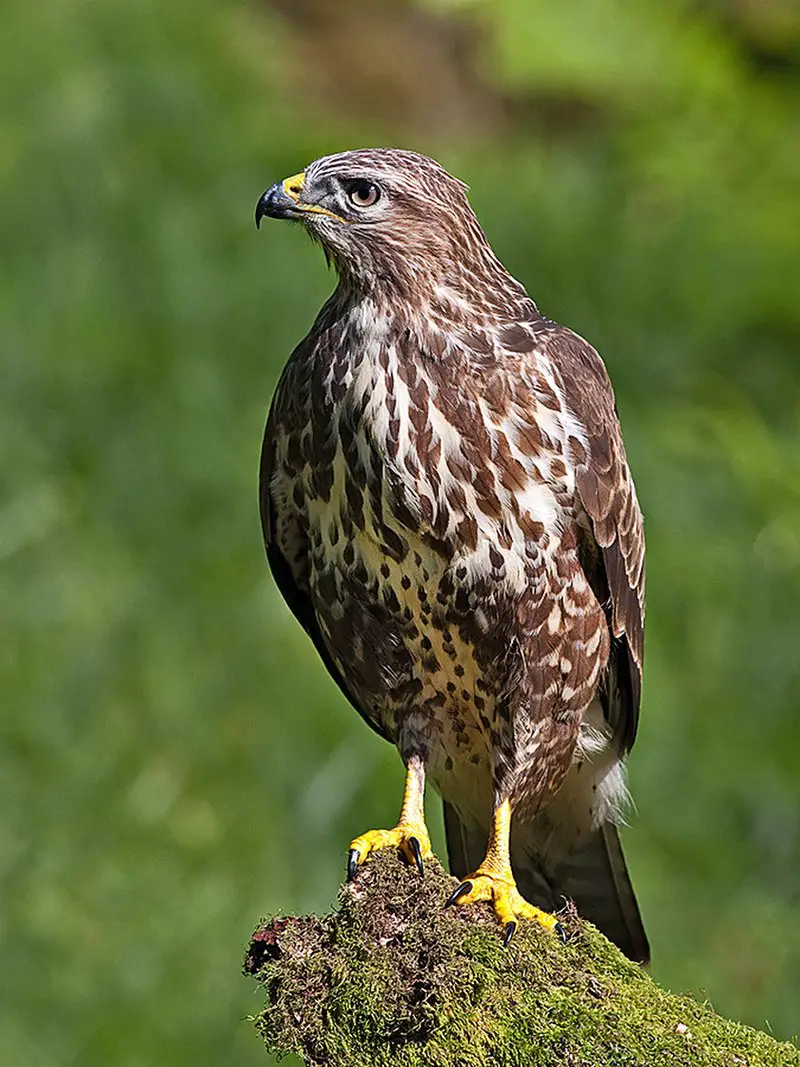
Accipitridae birds are a diverse family of raptors ranging in size from small to large. They have powerful hooked beaks which they use for hunting and tearing apart their prey, such as insects, medium-sized mammals and carrion.
Some species even feed on fruit. These birds can be found all over the world, making them an incredibly successful group of predators.
Accipitridae are adaptable hunters with keen eyesight that helps them spot potential meals from far away distances.
Their sharp talons assist them in grasping onto their victims while feeding or defending themselves against enemies.
Not only do these avian creatures provide us with visual beauty but also help keep our ecosystems healthy by keeping pest populations under control.Scientific classification:
| Kingdom | Animalia |
| Phylum | Chordata |
| Class | Aves |
| Order | Accipitriformes |
| Family | Accipitridae Vieillot, 1816 |
2. Tyrant Flycatchers
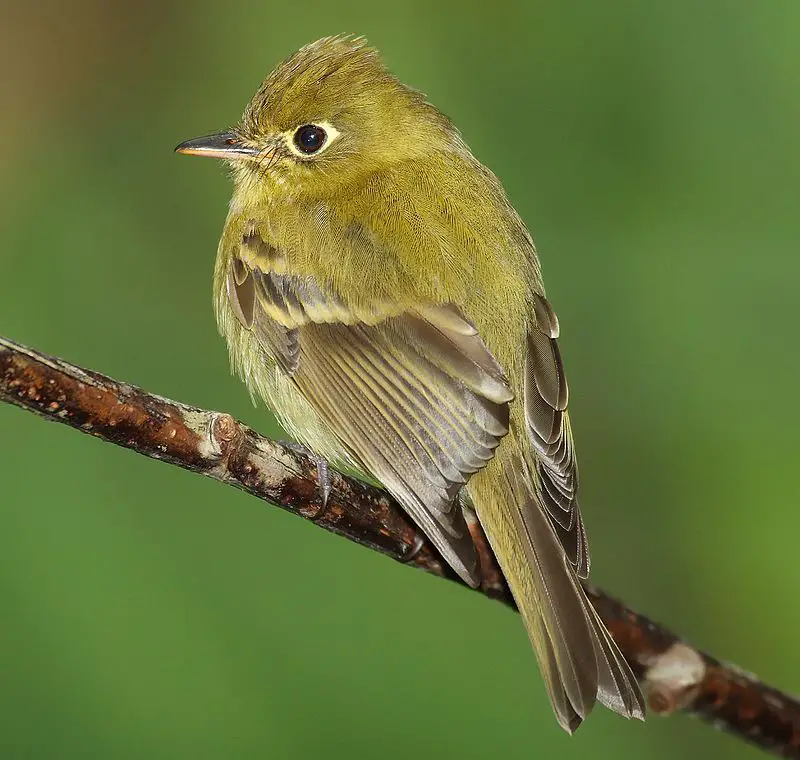
Tyrant flycatchers are a family of birds found in North and South America, containing over 400 species. These birds come in an array of shapes and sizes, with vibrant plumage to match.
They are the most diverse avian family across all countries they inhabit except for the United States and Canada.
Their diet consists mainly of insects but also includes small reptiles or amphibians where available.
The behavior varies between each bird; some prefer open areas while others like dense forests as their habitat � many even migrate regularly.
Tyrant Flycatchers have adapted well to human presence thanks to the abundance of food sources that often accompany it � such as backyards, parks etc..
All things considered these incredible creatures are truly amazing.Scientific classification:
| Kingdom | Animalia |
| Phylum | Chordata |
| Class | Aves |
| Order | Passeriformes |
| Parvorder | Tyrannida |
| Family | Tyrannidae Vigors, 1825 |
Also Featured In: Birds that You’ll Find in Puerto Rico, Most Common Birds in South America Birds
3. Andean Condor
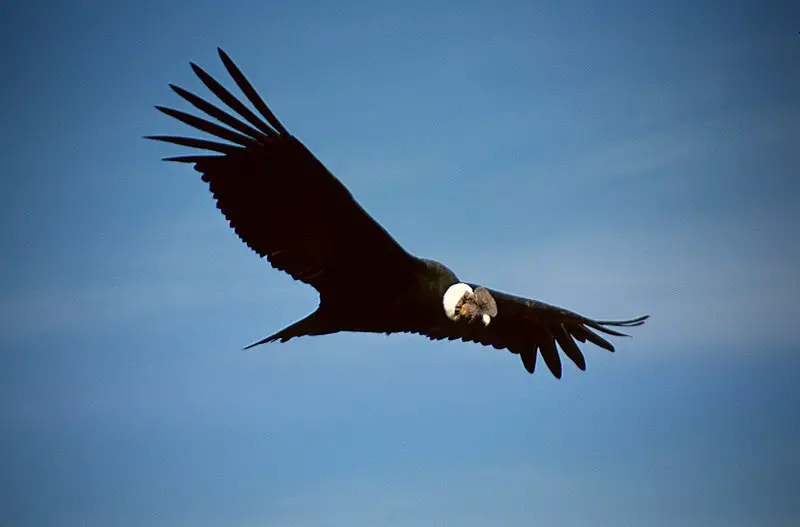
The Andean condor is a giant South American Cathartid vulture and the only member of its genus.
Found in the Andes mountains and along Pacific coasts, it is thought to be the largest flying bird on Earth by weight and wingspan with a maximum wingspan reaching up to 10 feet 10 inches (3.3 m) and weighing 33 lbs (15 kg).
It has mainly black plumage which helps keep it warm at high altitudes, while white patches adorn its head, neck, chest as well as underwing coverts.
Its powerful bill allows it to consume carrion efficiently while also being able to crack bones for nutrition when necessary.
The amazing flight capabilities of this majestic creature allow them soar through air thermals effortlessly; making them an impressive sight against clear blue skies.Scientific classification:
| Kingdom | Animalia |
| Phylum | Chordata |
| Class | Aves |
| Order | Accipitriformes |
| Family | Cathartidae |
| Genus | Vultur Linnaeus, 1758 |
| Species | V. gryphus |
4. Rufous Hornero
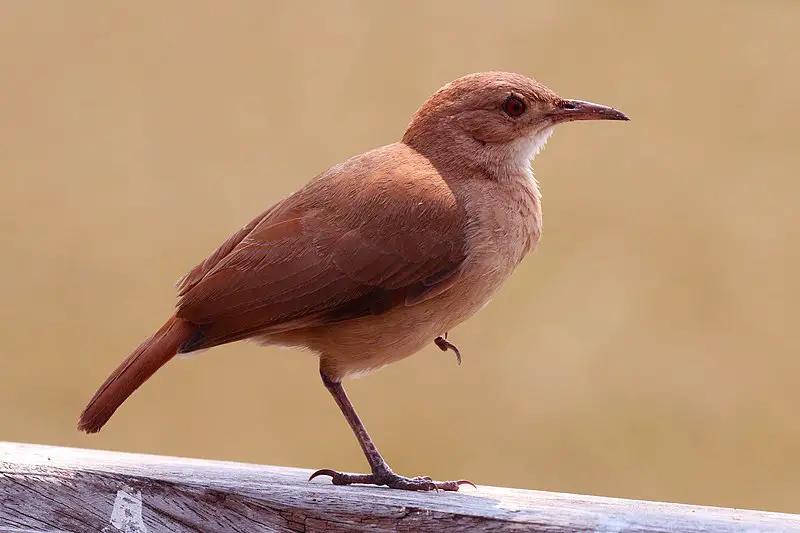
The Rufous Hornero is a small ovenbird found in eastern South America and is the national bird of Argentina. It has adapted to human environments such as pastures, agricultural land and second-growth scrub areas, making it synanthropic.
Its range stretches from midwestern Brazil to southern Bolivia, Paraguay, Uruguay and northern Argentina.
The species is easily identifiable by its rusty red plumage with dark streaks on the back of its neck along with white underparts that have black spots near their edges.
This medium-sized bird has impressive mud dome nests at top of trees or artificial structures like power poles where they lay two eggs each season which are incubated for about three weeks until hatching takes place.
They feed mainly on insects but also eat fruits when available during winter monthsScientific classification:
| Kingdom | Animalia |
| Phylum | Chordata |
| Class | Aves |
| Order | Passeriformes |
| Family | Furnariidae |
| Genus | Furnarius |
| Species | F. rufus |
Also Featured In: Common Latin America Birds, Birds that Make Mud Nests
5. Crested Caracara
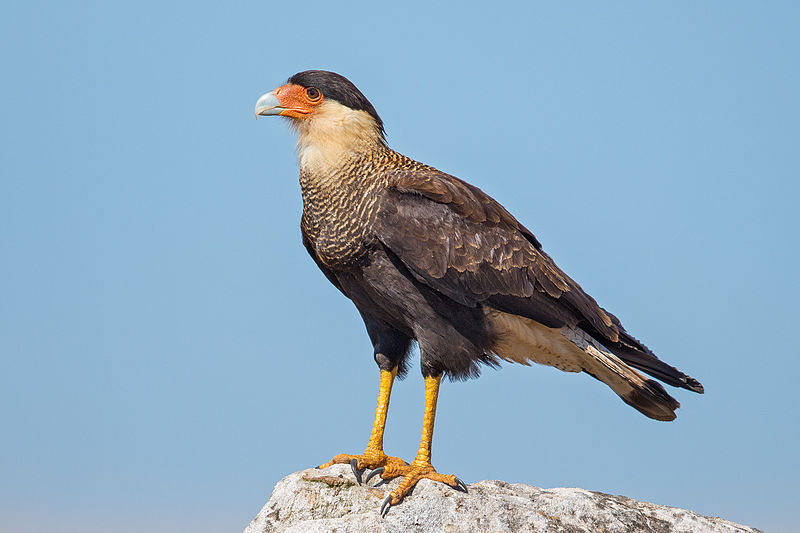
The Crested Caracara is a majestic bird of prey found from the Southern United States through Central and South America, all the way down to Tierra del Fuego.
It has an impressive wingspan ranging from 120-132 cm, with adults averaging 1,348 g in weight. This species is known for its characteristic crest on top of their head that can be raised when they are alarmed or excited.
They have pale yellow legs and feet along with dark brown feathers covering most of their body.
The Crested Caracara feeds mainly on carrion but will also take live food such as small mammals, reptiles and birds as well as garbage if it’s available near them.
These amazing raptors form strong family bonds between siblings which often last until adulthood; making them one of nature’s most remarkable creatures.Scientific classification:
| Kingdom | Animalia |
| Phylum | Chordata |
| Class | Aves |
| Order | Falconiformes |
| Family | Falconidae |
| Genus | Caracara |
| Species | C. plancus |
6. Eared Dove
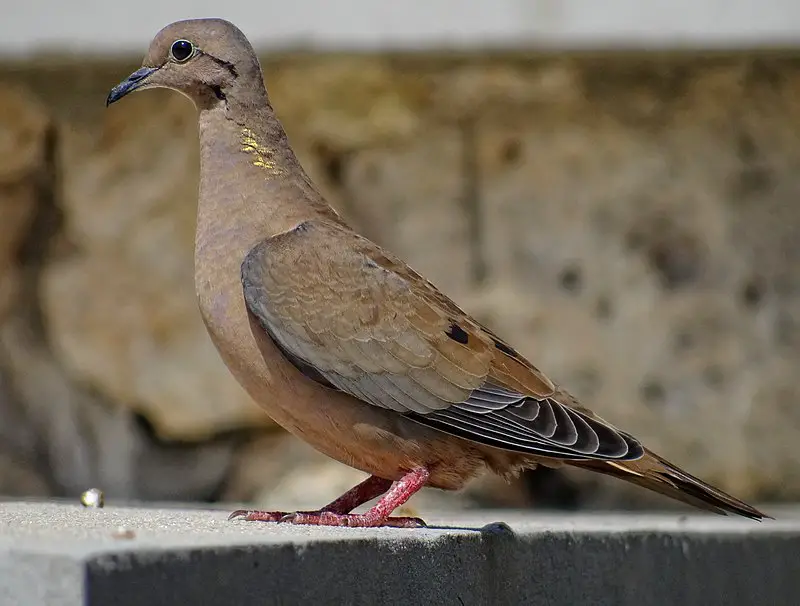
The Eared Dove is a beautiful bird that can be found throughout South America, ranging from Colombia to Argentina and Chile. It has also been spotted in Trinidad and Tobago recently.
This species tends to be partially migratory depending on food supplies available in the area, making it an important part of the local environment.
Its plumage tends to vary by region with some individuals having brighter colors than others where they are found near forested areas or along coasts.
The most recognizable feature of this dove is its ear tufts which gives it its common name – Eared Dove.
These doves have a soft cooing sound as their call which makes them truly unique among other birds in their range.Scientific classification:
| Kingdom | Animalia |
| Phylum | Chordata |
| Class | Aves |
| Order | Columbiformes |
| Family | Columbidae |
| Genus | Zenaida |
| Species | Z. auriculata |
7. Toco Toucan
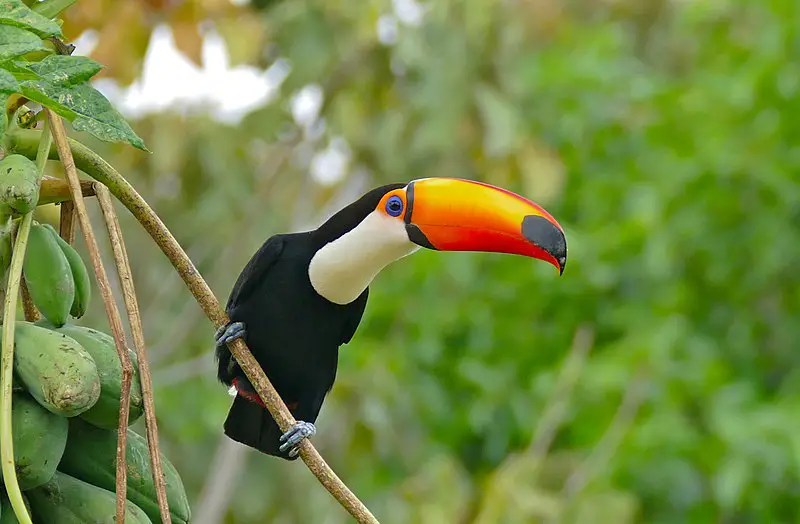
The Toco Toucan is the largest and most recognizable species of toucans, native to semi-open habitats in Central and Eastern South America.
First described by German zoologist Philipp Ludwig Statius Müller in 1776, this colorful bird has two subspecies – Ramphastos toco toco and Ramphastos toco cuvieri – distinguished by their slightly different size, plumage coloration, beak markings and range.
With its large orange bill covered with black spots along the sides of its face contrasting with yellow feathers on top of its head , it’s a very striking animal indeed.
Commonly found in zoos around the world too due tot heir loveable nature they are often kept as pets. They feed mainly on fruit but may also eat insects or small reptiles from time to time.
All in all these birds provide us a wonderful spectacle that we should appreciate for many years ahead.Scientific classification:
| Kingdom | Animalia |
| Phylum | Chordata |
| Class | Aves |
| Order | Piciformes |
| Family | Ramphastidae |
| Genus | Ramphastos |
| Species | R. toco |
8. Ovenbird
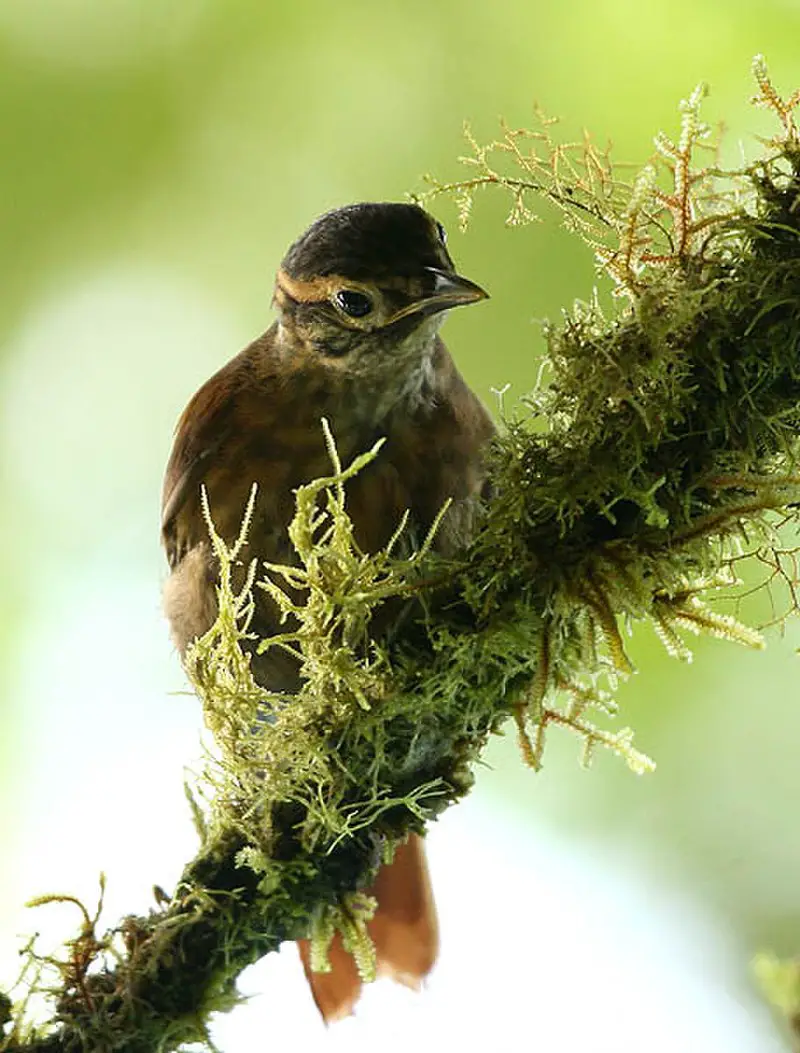
Ovenbirds are a family of small passerine birds found in Central and South America. They have around 315 species, divided into 70 genera. The most popular ovenbird is the Seiurus aurocapilla, which breeds in North America.
These birds typically inhabit wooded areas like forests or shrubland habitats, where they can forage for food such as insects and berries on the ground or low-lying vegetation.
Ovenbirds also build unique nests that resemble an oven with a side entrance—hence their name.
With its bright colours, melodic call and interesting nesting habits it’s no wonder why this bird has become so popular with birdwatchers worldwide.Scientific classification:
| Kingdom | Animalia |
| Phylum | Chordata |
| Class | Aves |
| Order | Passeriformes |
| Infraorder | Tyrannides |
| Family | Furnariidae Gray, 1840 |
Also Featured In: Birds that Migrate through Illinois in the Spring, Falkland Islands Birds You Need To Know
9. Kelp Gull
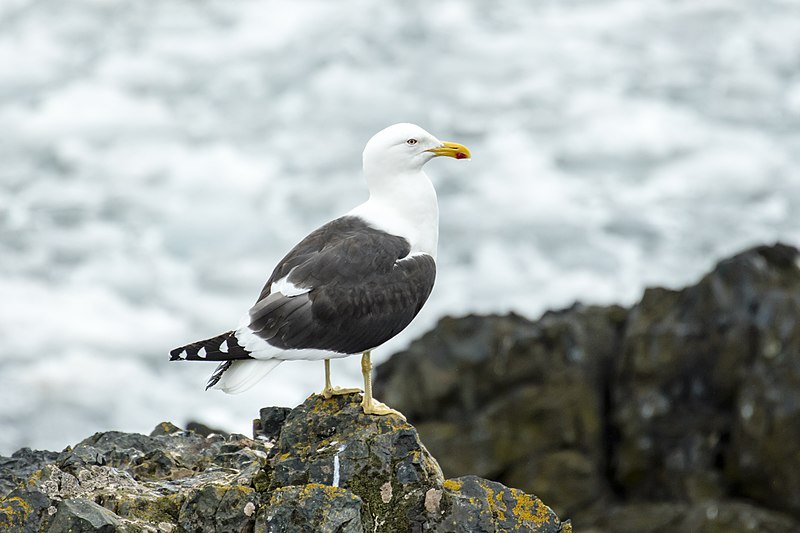
The Kelp Gull is a majestic bird that can be found on coasts and islands of the Southern Hemisphere. It has a beautiful plumage consisting of black, white and grey feathers with brown eyes.
Its wingspan ranges between 91-122 cm (36 – 48 inches). The nominate L. d. dominicanus subspecies is most commonly seen around South America, parts of Australia, and New Zealand where it goes by the name “black-backed gull” or “mollyhawk”.
These birds are omnivorous but tend to prefer fish as their primary food source while they also scavenge carrion when necessary.
In order to stand out from other seagulls during mating season they display vibrant courtship rituals which involve flying high in circles over its nesting area flapping their wings dramatically before diving down into the water near potential mates.Scientific classification:
| Kingdom | Animalia |
| Phylum | Chordata |
| Class | Aves |
| Order | Charadriiformes |
| Family | Laridae |
| Genus | Larus |
| Species | L. dominicanus |
10. Hornero
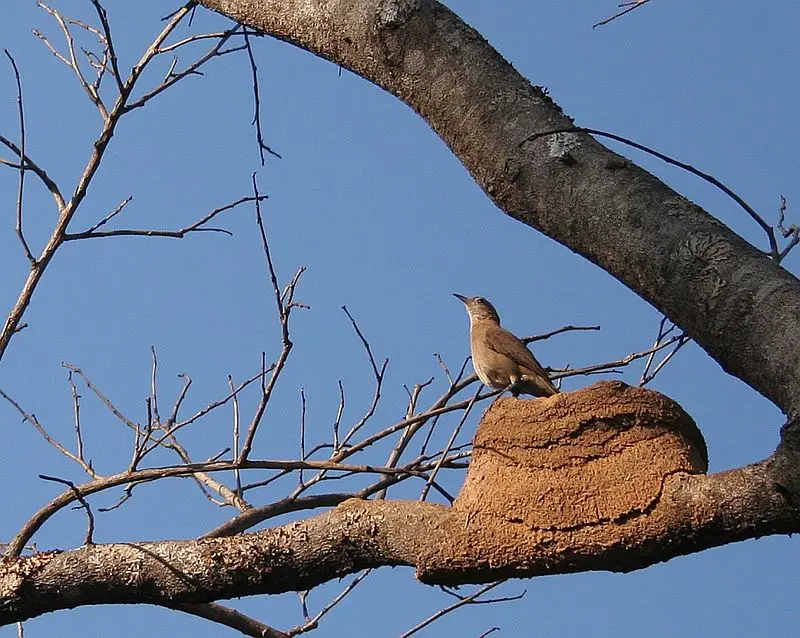
The Hornero bird is a member of the genus Furnarius in the family Furnariidae, found exclusively in South America. It has a distinct brown plumage and short tail as well as a long bill.
What makes it stand out amongst other birds are its mud oven-like nests made from clay or soil mixed with water that have an unusual chamber structure to them. Its name “Hornero” comes from horno meaning ‘oven’ which these nests closely resemble; making them unique among all avian species.
They use their strong bills to build intricate structures up high on tree branches for safety purposes too. The Horneros hard work surely pays off when they successfully protect themselves and lay eggs within this piece of artistry in nature – something we can certainly appreciate even if just by looking at it.Scientific classification:
| Kingdom | Animalia |
| Phylum | Chordata |
| Class | Aves |
| Order | Passeriformes |
| Family | Furnariidae |
| Genus | Furnarius Vieillot, 1816 |
11. Southern Giant Petrel
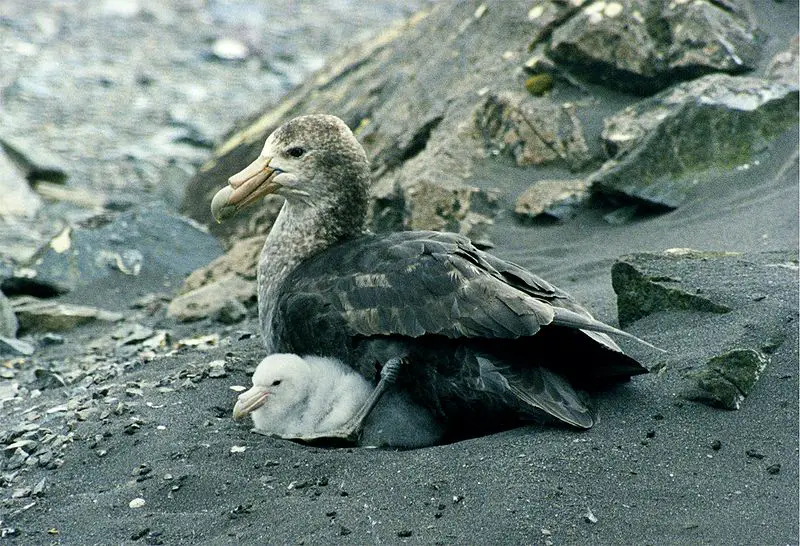
The Southern giant petrel is a large seabird native to the southern oceans, and it overlaps broadly with its similar counterpart, the Northern giant petrel.
Adults of both species can be distinguished by their bill-tip color: greenish in the south and yellowish in the north.
The Southern giant petrel also goes by other names such as Antarctic giant petrel, Giant fulmar, Stinker or Stinkpot.
These birds are around 75 cm (30 inches) long on average and have striking white plumage combined with brown wings that give them an impressive appearance while they soar through skies above open waters searching for food like fish, krill and squid – which they can catch up to 100 meters below sea level.Scientific classification:
| Kingdom | Animalia |
| Phylum | Chordata |
| Class | Aves |
| Order | Procellariiformes |
| Family | Procellariidae |
| Genus | Macronectes |
| Species | M. giganteus |
12. Rufescent Tiger Heron
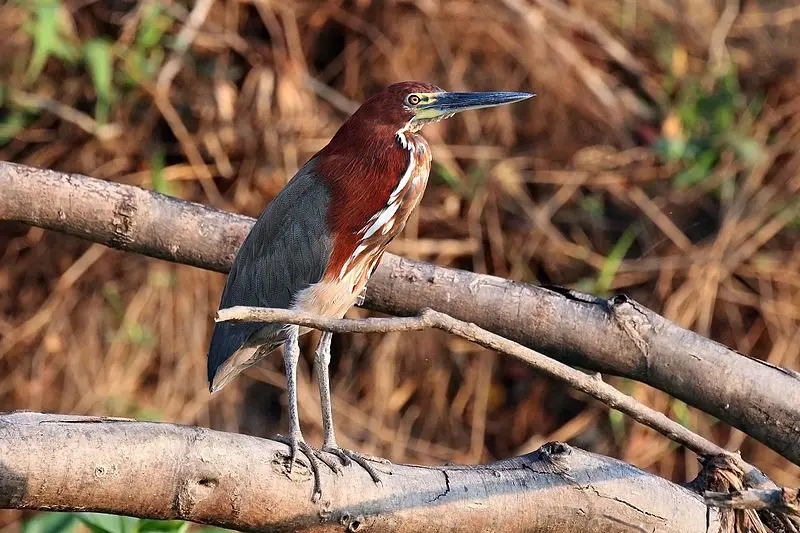
The Rufescent Tiger Heron is a species of heron found in wetlands from Central America to South America. It was first described by the French polymath Georges-Louis Leclerc, Comte de Buffon in 1780.
This majestic bird has a light brown body with dark barring on its wings and tail feathers. Its long beak curves downwards and its legs are yellowish-green.
The head is grayer than the rest of its body, giving it an almost regal appearance when seen in flight or perching atop trees near water bodies like rivers or lakes.
With their striking colours and size – reaching up to 90cm tall – they can easily stand out against other birds.Scientific classification:
| Kingdom | Animalia |
| Phylum | Chordata |
| Class | Aves |
| Order | Pelecaniformes |
| Family | Ardeidae |
| Genus | Tigrisoma |
| Species | T. lineatum |
Also Featured In: Birds that Live in Guyana,
13. Hooded Grebe
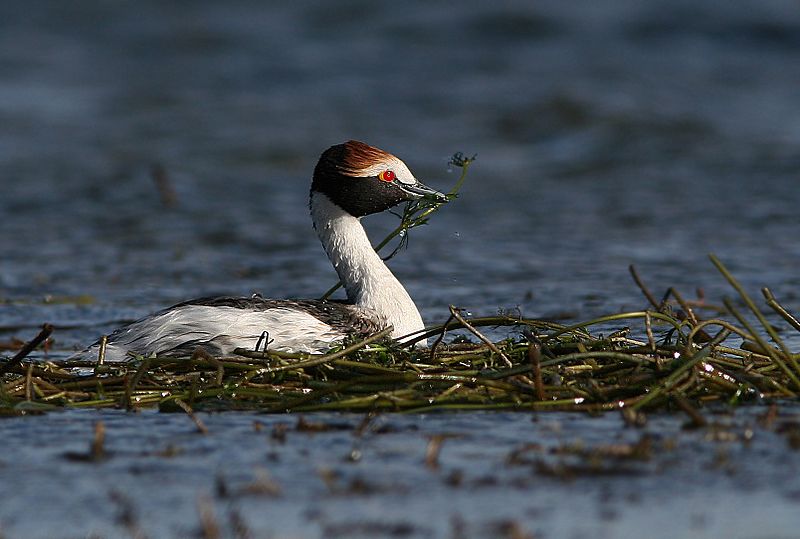
The Hooded Grebe is a small bird native to the southern region of Argentina. It grows up to 13 inches in length and has striking black-and-white plumage.
This species inhabits isolated lakes in Patagonia, spending its winters along the coastlines of this remote area.
In 2012, it was uplisted from Endangered to Critically Endangered on IUCN’s Red List due to its declining population numbers caused by human activities such as hunting and pollution.
The Hooded Grebe can be identified by its white chin patch and yellow eyes surrounded by red rings – making for an impressive sight when seen flying across their home waters.
Conservation efforts are essential for safeguarding this unique species so that future generations may enjoy admiring them in their natural habitats.Scientific classification:
| Kingdom | Animalia |
| Phylum | Chordata |
| Class | Aves |
| Order | Podicipediformes |
| Family | Podicipedidae |
| Genus | Podiceps |
| Species | P. gallardoi |
Also Featured In: Patagonia Birds You Should Know,
14. Black-Necked Swan
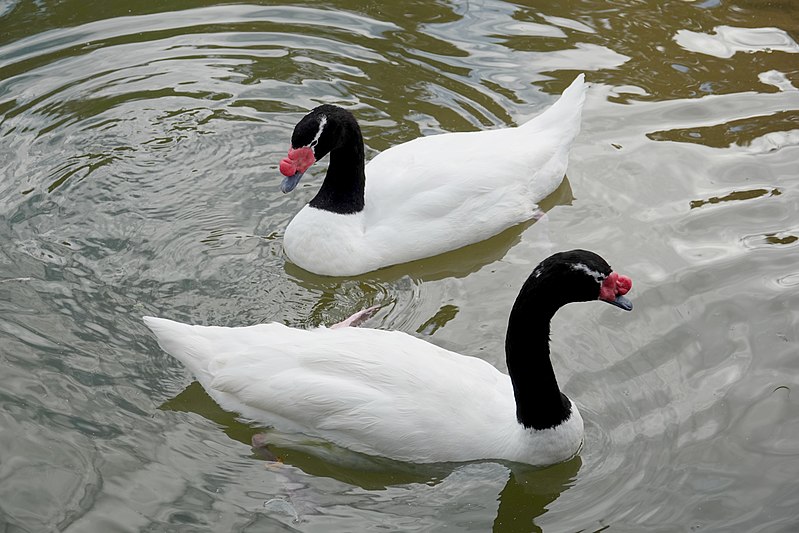
The Black-necked Swan is a species of waterfowl belonging to the Cygnini tribe in subfamily Anserinae. They are native to Argentina, Brazil, Chile, Uruguay and the Falkland Islands.
The black-necked swan has been known to stand out from other members of its family due to its unique appearance; it has an all white body with a black neck and head.
This bird typically lives near freshwater bodies such as lakes or rivers but can also be found on ocean coasts during some seasons when food sources become scarce.
It mainly feeds on algae and aquatic plants though occasionally eats small fish too for extra nutrition.
Overall this gorgeous bird stands proud amongst many others because of their stunning colour combination which makes them unmistakable.Scientific classification:
| Kingdom | Animalia |
| Phylum | Chordata |
| Class | Aves |
| Order | Anseriformes |
| Family | Anatidae |
| Genus | Cygnus |
| Species | C. melancoryphus |
Also Featured In: Common Birds in Chiloé Island,
15. Southern Lapwing
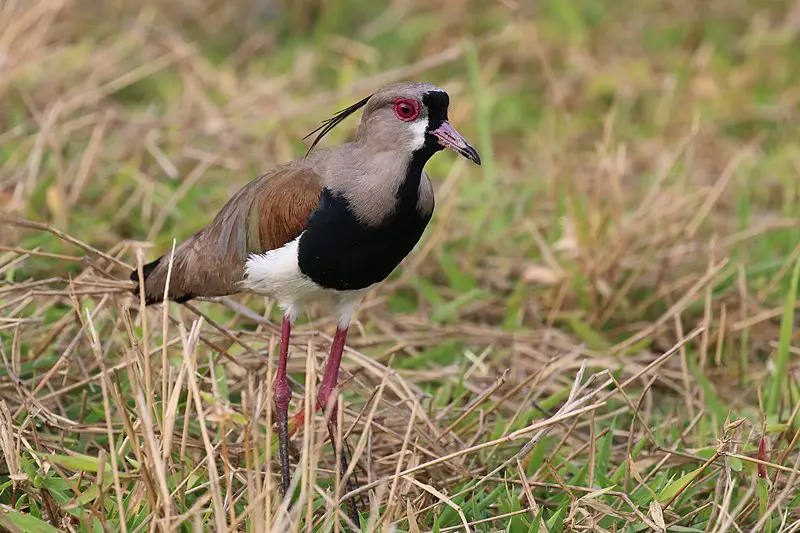
The Southern lapwing, also known as quero-quero in Brazil or tero in Argentina and Uruguay, is a wader that can be found throughout South America.
It inhabits open areas like grasslands and fields but avoids heavily forested regions such as the Amazon basin.
This bird has an unmistakable appearance with its black-and-white plumage contrasting against its bright yellow bill and legs.
The male’s feathers are more vibrant than those of the female, making them easily distinguishable from each other.
They feed on worms and insects which they search for by probing their long bills into soft ground while walking around looking for food.
Lapwings are highly territorial birds who will protect their nests fiercely from any potential predators or intruders.Scientific classification:
| Kingdom | Animalia |
| Phylum | Chordata |
| Class | Aves |
| Order | Charadriiformes |
| Family | Charadriidae |
| Genus | Vanellus |
| Species | V. chilensis |
16. Ruddy Ground Dove
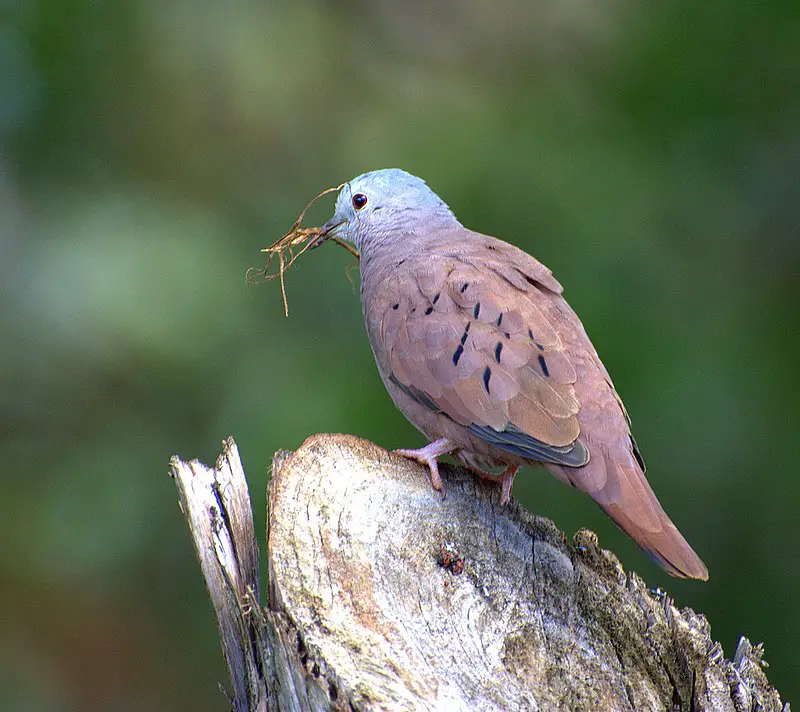
The Ruddy Ground Dove is a small New World tropical bird, found across Mexico and South America as far south as Argentina. It is also seen in the southwestern United States during winter months.
This ground dove typically lives in scrub or other open habitats such as savannas and grasslands, where it feeds on seeds from plants like cactus fruits.
Its plumage ranges from grey to reddish-brown with a light tan breast and black markings throughout its wings and tail feathers.
The male has more distinguishable colouration than the female but both sexes have bright red eyes which give this species its name – ‘ruddy’.
They are often observed perching low to the ground near food sources or nesting sites while also being quite vocal when flying between locations making them easier to spot.Scientific classification:
| Kingdom | Animalia |
| Phylum | Chordata |
| Class | Aves |
| Order | Columbiformes |
| Family | Columbidae |
| Genus | Columbina |
| Species | C. talpacoti |
17. Austral Rail
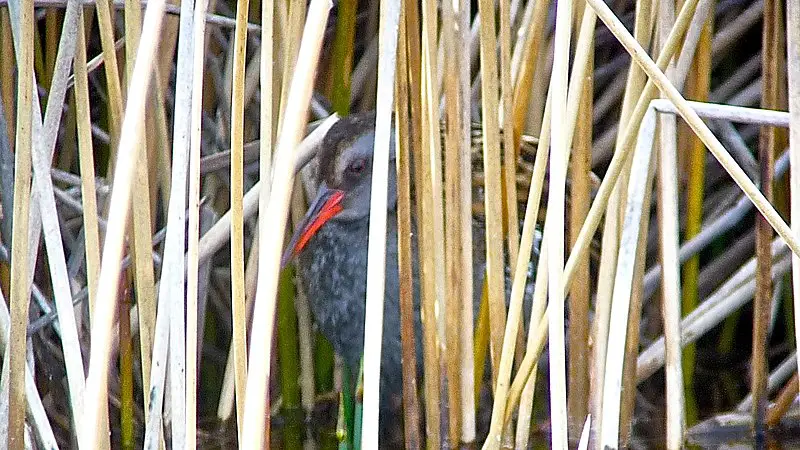
The Austral Rail is a vulnerable species of bird found primarily in Argentina and Chile. It belongs to the Rallinae subfamily of the family Rallidae, which includes rails, gallinules and coots.
While some have suggested that it be classified as conspecific with Virginia Rails (R. limicola), this has not been widely accepted by experts.
The austral rail is monotypic; there are no other known species within its genus or family that share similar physical characteristics or behaviors.
Its diet consists mostly of small insects such as grasshoppers, crickets, caddisflies and mayflies supplemented occasionally with vegetation like seeds and leaves during winter months when insect sources become scarce.
Conservation efforts must continue if we wish to keep this unique creature safe from extinction.Scientific classification:
| Kingdom | Animalia |
| Phylum | Chordata |
| Class | Aves |
| Order | Gruiformes |
| Family | Rallidae |
| Genus | Rallus |
| Species | R. antarcticus |
18. Anhinga
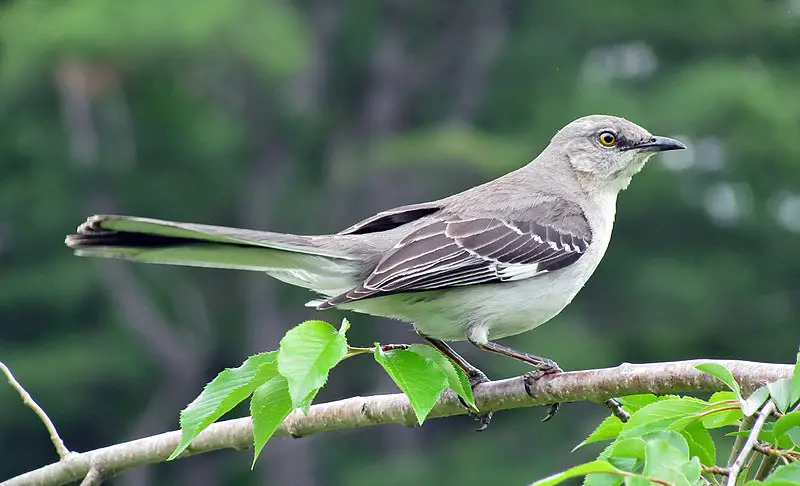
Anhinga, also known as a water turkey or snake bird, is a medium-sized aquatic bird found in wetlands across the Americas. It has long wings and neck with sharp pointed bill which make it look like a snake when swimming underwater.
Its dark feathers are waterproof and they help it to swim more efficiently while hunting for food under the surface of the water. Anhingas use their long necks to spear fish from underneath, then shake its head back and forth before swallowing them whole.
They can be seen perched on tree branches near bodies of water drying out their wings in the sun after diving dives for prey.
During breeding season males construct large nests made out of sticks located high up in trees above shallow waters where females lay eggs that hatch into fluffy downy chicks ready to explore their new wetland home.
19. Jacanas
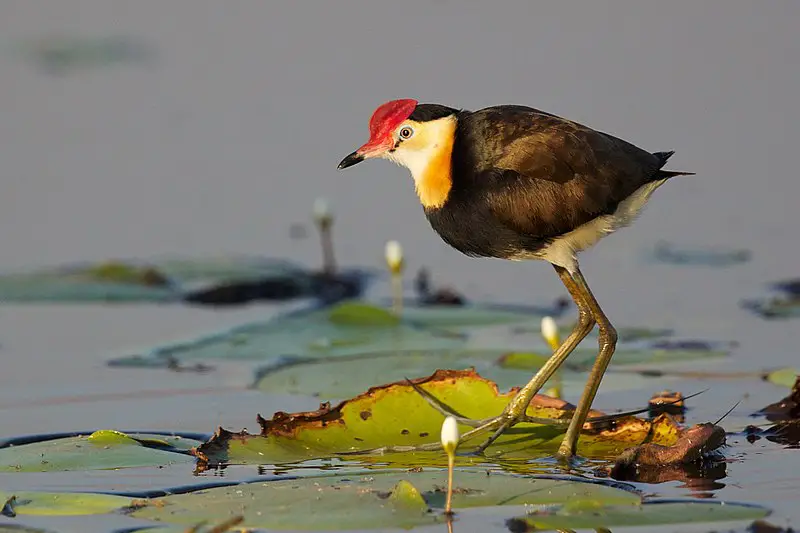
Jacanas are tropical waders belonging to the Jacanidae family. They have distinctive elongated toes and toenails which help them forage on floating or semi-emergent aquatic vegetation.
This adaptation gives them their nickname “Jesus birds” as they seem to be able to walk on water.
The female jacanas are also unique amongst bird species in that they take charge of nest building, incubation and caring for young while males perform courtship displays.
These unusual birds can be found throughout the world’s tropical regions where they inhabit wetlands such as swamps, marshes and shallow lakes with lily pads.
With a wide variety range due their special adaptations these beautiful creatures will surely continue living life at ease around our planet’s warmest waters.Scientific classification:
| Kingdom | Animalia |
| Phylum | Chordata |
| Class | Aves |
| Order | Charadriiformes |
| Suborder | Thinocori |
| Family | Jacanidae Stejneger, 1885 |
20. Painted-Snipe
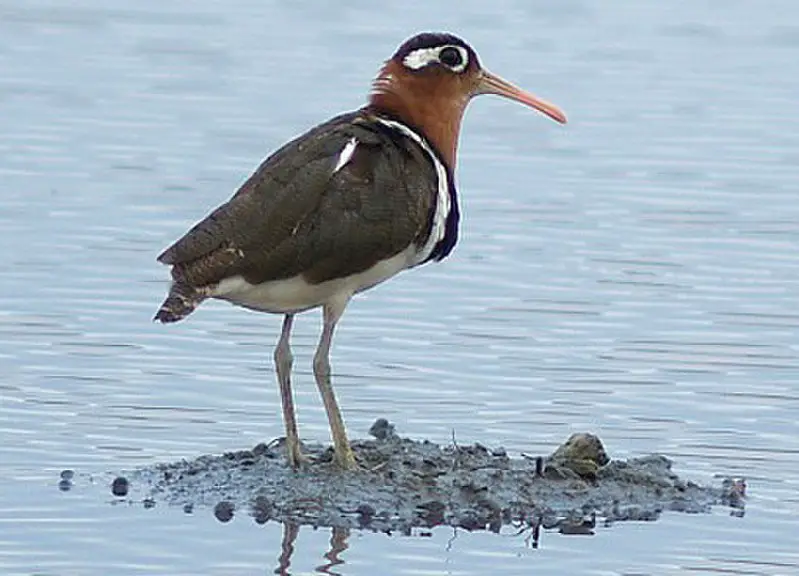
Painted snipes are beautiful and unique wading birds found in the Rostratulidae family. They have short legs, long bills, and a striking plumage which distinguishes them from true snipes.
Males tend to be smaller than females with duller overall coloration. There are three species of painted snipe.
The Greater Painted Snipe, Lesser Painted Snipe, and Australian Painted Snipe – all three have different habitats ranging from wetland pools to grasslands or mangroves depending on their region.
These birds feed mainly on earthworms but also consume insects, crustaceans and plant material when available.
As they rely heavily on wetlands for breeding purposes it is important that we protect these precious habitats so that this special bird can continue to thrive.Scientific classification:
| Kingdom | Animalia |
| Phylum | Chordata |
| Class | Aves |
| Order | Charadriiformes |
| Suborder | Thinocori |
| Family | Rostratulidae Coues, 1888 |
21. Heliornithidae
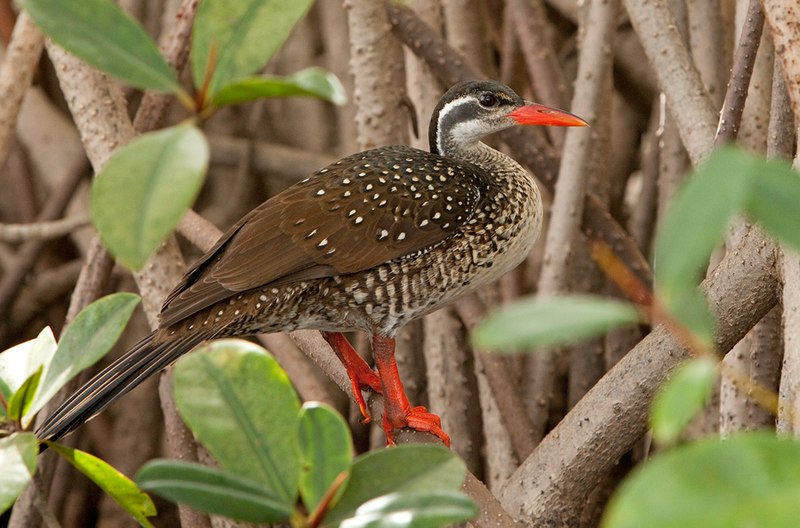
Heliornithidae, commonly known as finfoots, are a small family of tropical birds found in South America and Africa. They have webbed feet like grebes or coots, long necks, slender bodies and broad tails with sharp pointed bills.
Their diverse calls include whistles, squawks and croaks which they use to communicate with each other.
Finfoots feed mainly on fish but also consume insects such as water beetles and dragonflies near the surface of waterbodies.
They nest around rivers or lakes where there is plenty of cover from predators such as eagles or hawks.
During breeding season males can become quite territorial defending their territories against intruders by chasing them off aggressively using loud noises or even physical contact if necessary.Scientific classification:
| Kingdom | Animalia |
| Phylum | Chordata |
| Class | Aves |
| Order | Gruiformes |
| Family | Heliornithidae GR Gray, 1840 |
22. Seedsnipe
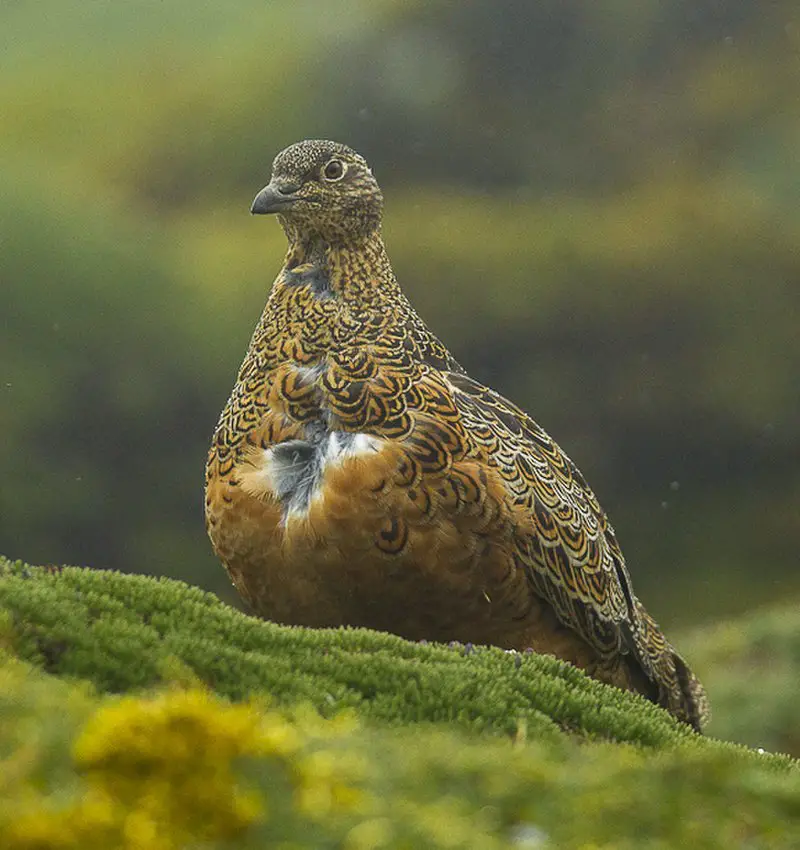
Seedsnipes are small wading birds from South America, mainly found in Andean and Patagonian regions. They form two genera – Attagis and Thinocorus – each containing two species.
Seedsnipes live in flocks and have adapted to a herbivorous diet. Although their exact relationship with other families of the Charadriiformes order is unknown, it has been suggested that they may be related to plovers or sandpipers.
These tiny birds feed on vegetation such as grass seeds, buds, shoots and leaves which they find among rocks or sparsely vegetated areas at high altitudes. Their brown-and-white plumage blend perfectly into their environment making them difficult to spot while feeding.Scientific classification:
| Kingdom | Animalia |
| Phylum | Chordata |
| Class | Aves |
| Order | Charadriiformes |
| Suborder | Thinocori |
| Family | Thinocoridae Gray, 1845 |
23. New World Quail
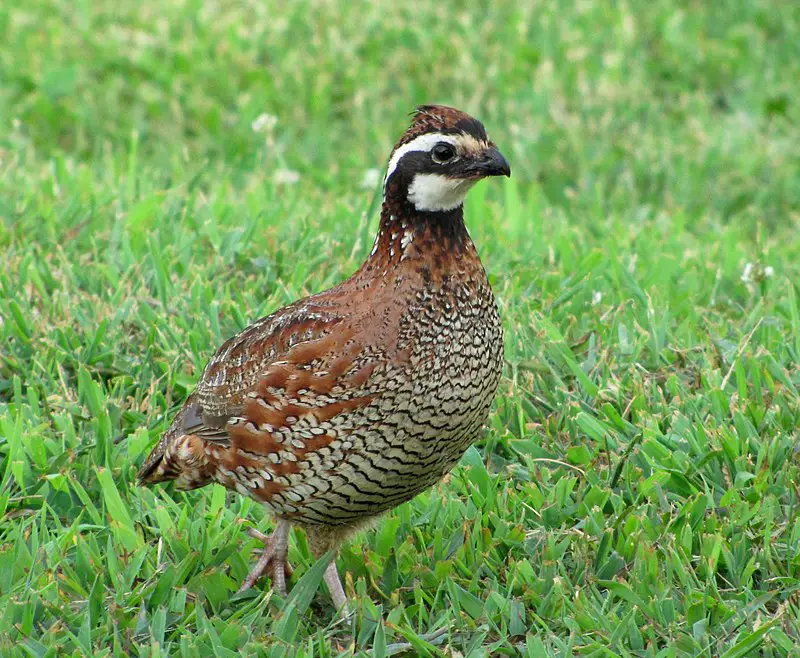
New World quail are small birds found in the Americas, from Canada to Brazil. They belong to their own family, Odontophoridae, and have similar appearance and habits as Old World quail which belong to a different family.
New World Quails come in various species such as California Quail and Bobwhite Quail.
These birds have adapted well to human presence due to availability of food resources like agricultural crops.
They also live close together where they form large flocks for safety against predators like foxes or hawks.
The males usually sport colorful feathers during mating season that helps them attract female mates while providing an amazing sight for us viewers.Scientific classification:
| Kingdom | Animalia |
| Phylum | Chordata |
| Class | Aves |
| Order | Galliformes |
| Superfamily | Phasianoidea |
| Family | Odontophoridae Gould, 1844 |
24. Jacamars
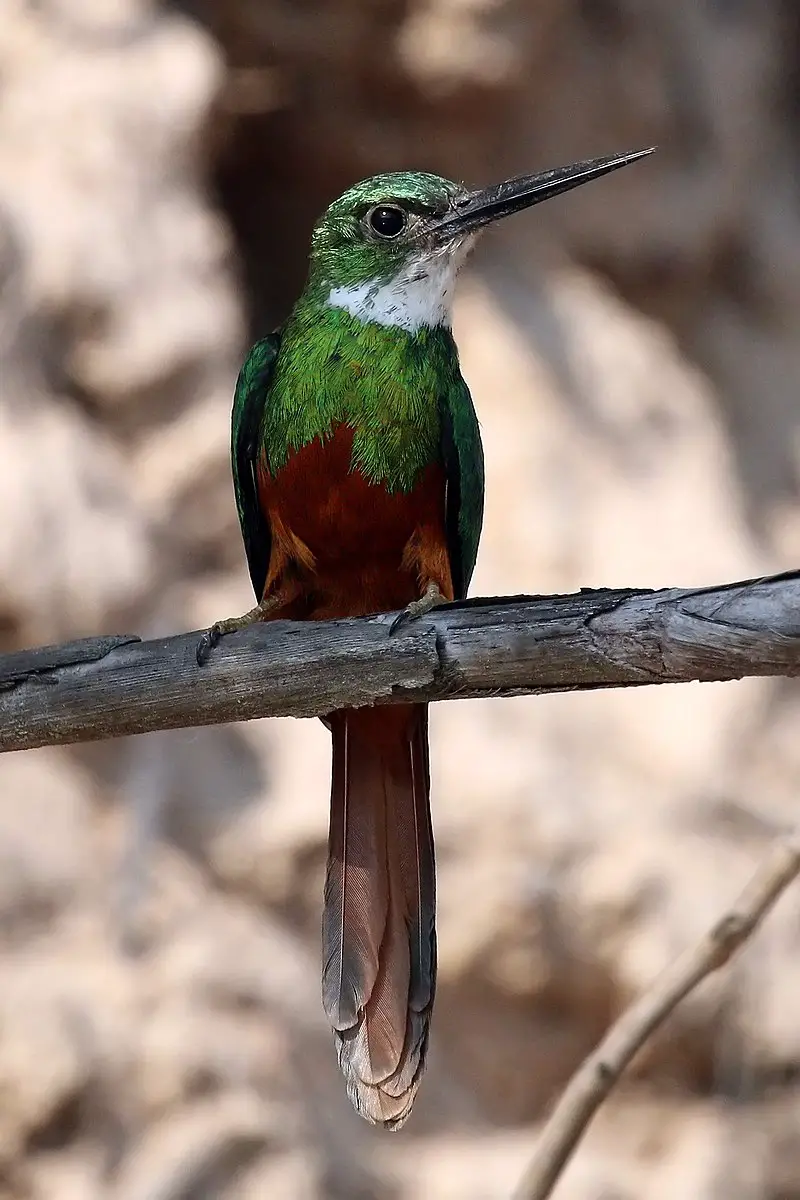
Jacamars are tropical birds native to South and Central America, extending as far north as Mexico. They belong to the Galbulidae family which consists of five genera and eighteen species in total.
These captivating birds can be easily distinguished by their unique appearance; they have long sharp bills with bright vivid plumage ranging from blues, greens and yellows that create a beautiful contrast against the lush vegetation of their natural habitat.
Jacamars prefer to inhabit dense forested areas near rivers or streams where they use their agile wings for quick flight maneuvers while hunting insects, lizards and frogs.
With an unmistakable presence these fascinating feathered creatures make a remarkable addition to any backyard bird sanctuary.Scientific classification:
| Kingdom | Animalia |
| Phylum | Chordata |
| Class | Aves |
| Order | Piciformes |
| Suborder | Galbuli |
| Family | Galbulidae Vigors, 1825 |
25. Plovers

Plovers are a family of around 64-68 species of ground-dwelling birds, commonly found in open country such as fields, meadows and tundras.
They have short bills with webbed feet to help them forage through mud or shallow water.
Plover plumage is usually mottled brown though some species may have brighter colors on the head and wings.
These birds feed mainly on insects but can also eat small crustaceans and worms.
Plovers breed during springtime when they dig holes in sandy or pebbled beaches to lay their eggs which hatch after about 3 weeks incubation period.
They use distraction display behaviour by pretending an injury to the predators away from their nests if needed for protecting their young ones.Scientific classification:
| Kingdom | Animalia |
| Phylum | Chordata |
| Class | Aves |
| Order | Charadriiformes |
| Family | Charadriidae Leach, 1820 |
26. Stilts And Avocets
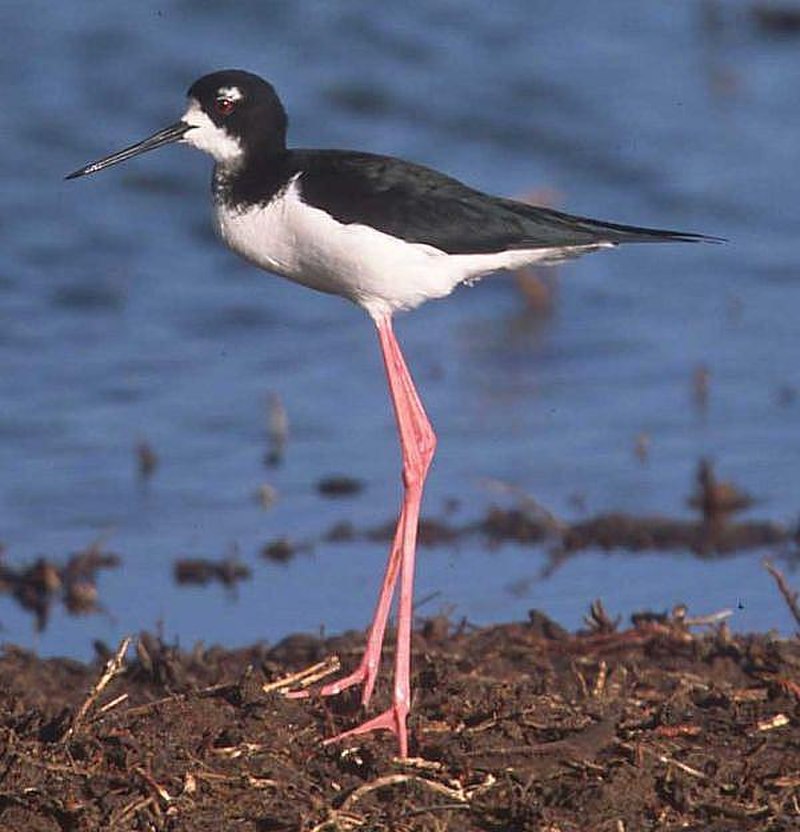
Stilts and avocets are two distinct groups of birds belonging to the family Recurvirostridae. They range in length from 30-46 cm (12-18 inches) and weigh between 140 – 435 g (4.9 – 15.3 ounces).
Males usually have slightly larger bodies than females, with long thin legs, necks and bills.
Avocet bills curve upwards uniquely while stilt beaks remain straight most times.
These wading birds live mainly near shorelines or wetlands where they feed on aquatic invertebrates like brine shrimp, insects etc., occasionally supplementing their diet with seeds or small fish too.
Stilts also inhabit open fields in search of food sources such as earthworms or grasshoppers during the non-breeding season.
Both groups migrate over large distances for warmer weathers when it gets cold outside.Scientific classification:
| Kingdom | Animalia |
| Phylum | Chordata |
| Class | Aves |
| Order | Charadriiformes |
| Suborder | Charadrii |
| Family | Recurvirostridae Bonaparte, 1854 |
27. Cracidae
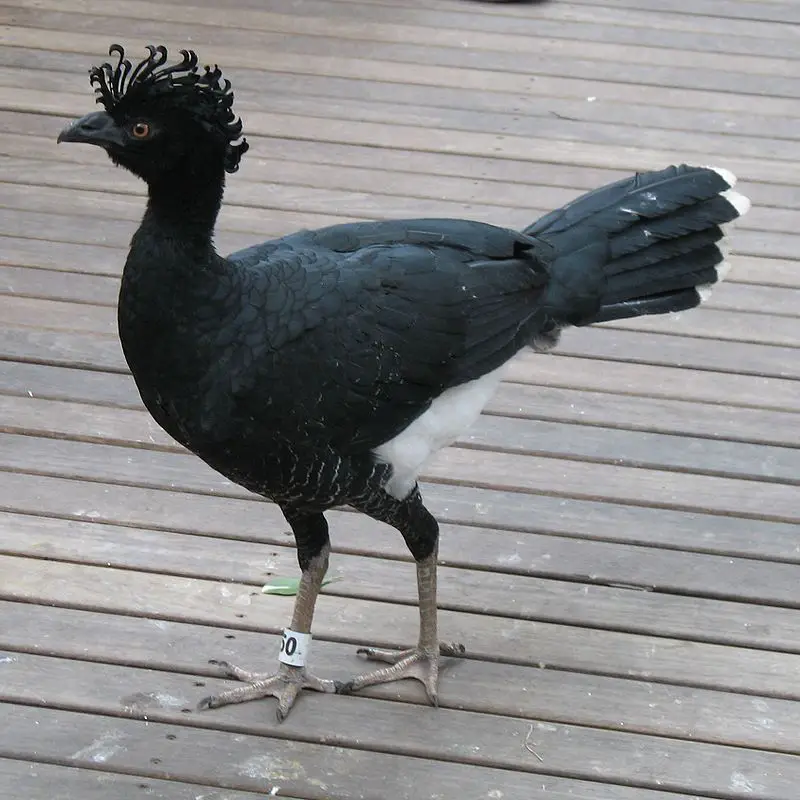
Cracidae is a family of tropical and subtropical birds found in Central and South America. The most well-known species are chachalacas, guans, and curassows.
These birds can also be seen in southern parts of Texas in the United States as well as Trinidad & Tobago islands. They typically have long tails with a rounded tip that helps them keep balance during flight or when perched on branches.
Moreover, they usually have short wings so they don’t fly very far but rather hop from tree to tree within their habitat range.
Cracids use their sharp claws for climbing trees while searching for food such as fruits, nuts insects etc.. Some members of this bird family are considered endangered due to hunting pressure by humans or loss of habitats caused by deforestation activities among others factorsScientific classification:
| Kingdom | Animalia |
| Phylum | Chordata |
| Class | Aves |
| Order | Galliformes |
| Family | Cracidae Rafinesque, 1815 |
28. Solitary Tinamou
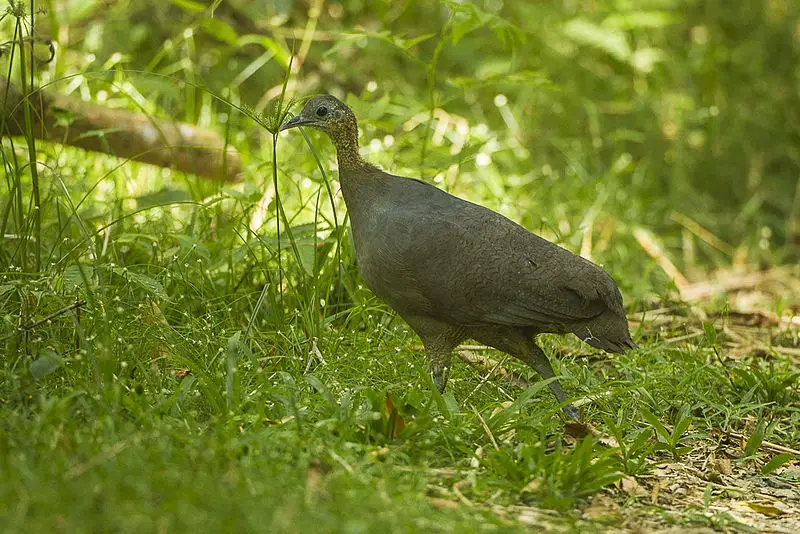
The Solitary Tinamou is a species of paleognath ground bird native to the Atlantic forest in eastern Brazil. It belongs to the family Tinamidae, making it a ratite- one of only four surviving prehistoric flightless birds.
Although they can fly, their flying capabilities are not as strong and powerful compared to other birds. With its brown feathers with streaks or bands of blackish coloration on its upperparts and whitish underneath, this tinamou has adapted well for life on land; living amongst forests and shrubs close to streams or rivers.
Some threats that affect them include habitat loss due to deforestation but also hunting by humans which could eventually lead these lovely creatures into extinction if nothing changes soon.Scientific classification:
| Kingdom | Animalia |
| Phylum | Chordata |
| Class | Aves |
| Infraclass | Palaeognathae |
| Order | Tinamiformes |
| Family | Tinamidae |
| Genus | Tinamus |
| Species | T. solitarius |
29. Nacunda Nighthawk

The Nacunda nighthawk is a species of nightjar belonging to the family Caprimulgidae. It can be found in South America, extending from Argentina and Bolivia to Venezuela and Trinidad & Tobago.
These birds prefer dry savannas or grasslands as their habitat but are also accustomed to heavily degraded areas once used for forestry purposes.
They feed on moths, beetles and other insects that they catch while flying at dusk or dawn near rivers or lakes.
The typical plumage consists of gray-brown upperparts with white spots across its wings and tail feathers; breast has black streaks running down it whereas its belly is usually whitish in colouration.
Despite being well studied, there isn’t much known about this bird’s breeding behaviour as nesting sites have rarely been observed due to them being hidden away within dense vegetation surrounding wetlands or flooded forestsScientific classification:
| Kingdom | Animalia |
| Phylum | Chordata |
| Class | Aves |
| Order | Caprimulgiformes |
| Family | Caprimulgidae |
| Genus | Chordeiles |
| Species | C. nacunda |
30. Andean Gull
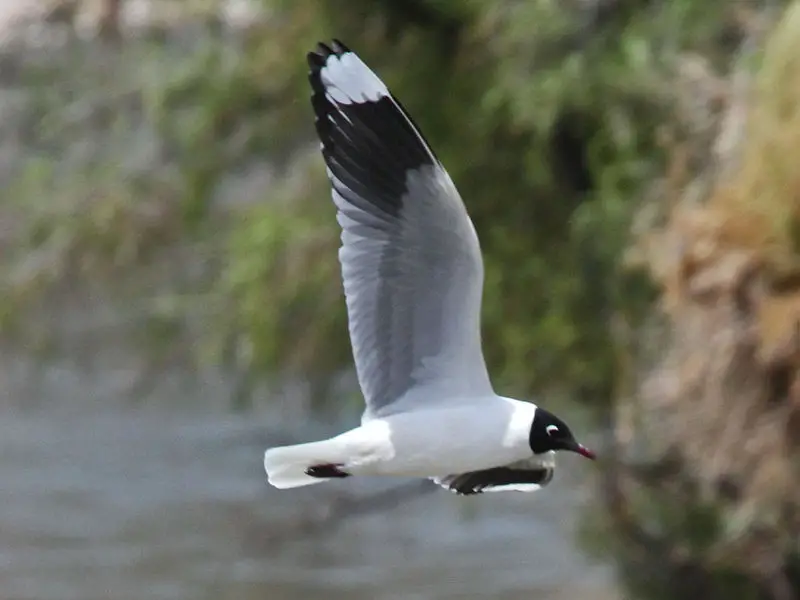
The Andean Gull is a species of gull found in the mountainous regions of Argentina, Bolivia, Chile, Colombia, Ecuador and Peru. It stands out from other gulls as it prefers to breed inland in mountain areas rather than near bodies of water like most others.
The bird can be seen around rivers or freshwater sources such as lakes and streams. They are medium-sized with white heads that contrast their dark brown bodies. Their wingspan ranges between 80–95 cm with an average weight ranging between 500-700 grams depending on gender .
These birds have adapted well to living at high altitudes where they feed mainly on insects but also take advantage of any food scraps left by humans when available.Scientific classification:
| Kingdom | Animalia |
| Phylum | Chordata |
| Class | Aves |
| Order | Charadriiformes |
| Family | Laridae |
| Genus | Chroicocephalus |
| Species | C. serranus |
31. Fulvous Whistling Duck
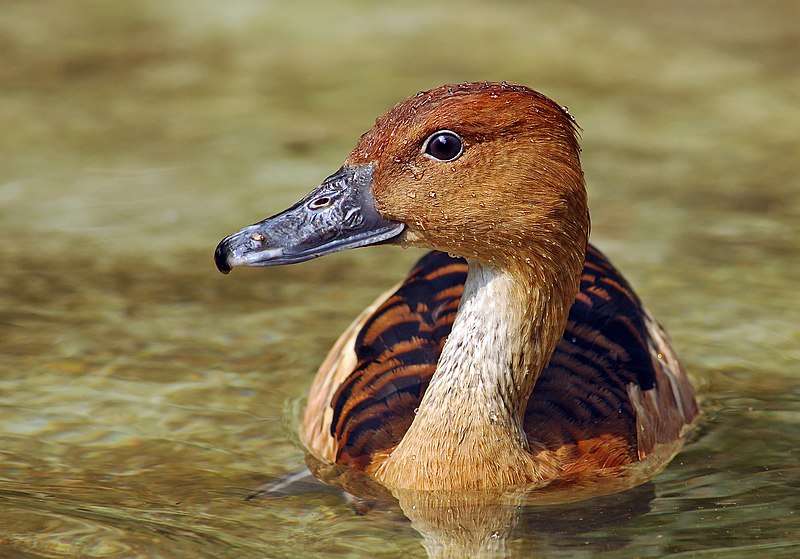
The Fulvous Whistling Duck is a species of whistling duck that can be found in tropical regions around the world.
It has a reddish-brown plumage, long legs and grey bill with distinctive white band across it.
This bird usually lives near water sources like wetlands or marshes where they feed on seeds, plants and small insects which make up their diet.
The male ducks are known to produce loud calls at night during breeding season as part of courtship rituals for attracting female partners.
They also congregate together in flocks when migrating from one area to another making them visible even from far distances.
Overall these amazing birds add beauty and joy to any natural environment.Scientific classification:
| Kingdom | Animalia |
| Phylum | Chordata |
| Class | Aves |
| Order | Anseriformes |
| Family | Anatidae |
| Genus | Dendrocygna |
| Species | D. bicolor |
Also Featured In: Caribbean Birds, Brown Birds of Florida
32. Trogoniformes

Anhinga, also known as a water turkey or snake bird, is a medium-sized aquatic bird found in wetlands across the Americas. It has long wings and neck with sharp pointed bill which make it look like a snake when swimming underwater.
Its dark feathers are waterproof and they help it to swim more efficiently while hunting for food under the surface of the water. Anhingas use their long necks to spear fish from underneath, then shake its head back and forth before swallowing them whole.
They can be seen perched on tree branches near bodies of water drying out their wings in the sun after diving dives for prey.
During breeding season males construct large nests made out of sticks located high up in trees above shallow waters where females lay eggs that hatch into fluffy downy chicks ready to explore their new wetland home.
33. Coraciiformes
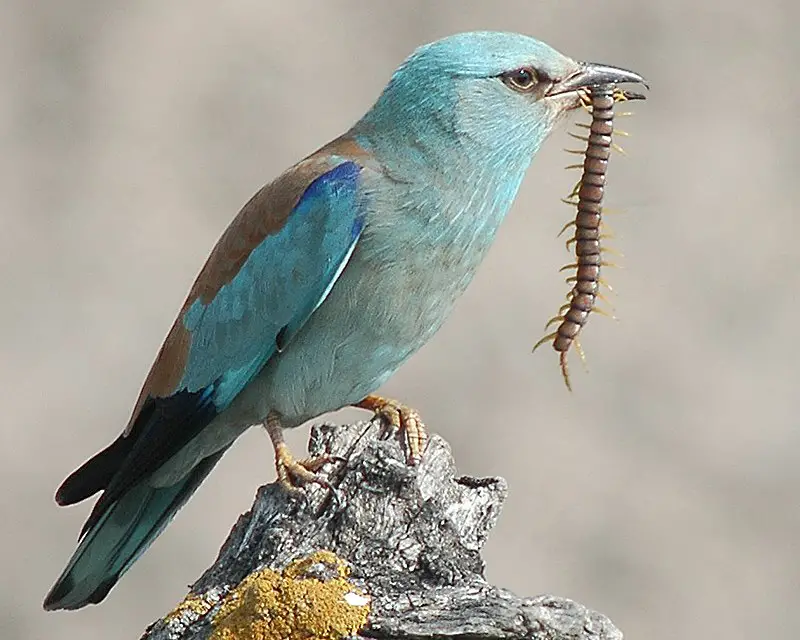
Coraciiformes birds are a group of beautiful and vibrant species, including kingfishers, bee-eaters, rollers, motmots and todies. They have syndactyly feet with three forward pointing toes (with their third and fourth fused at the base).
However in some kingfisher species one toe is absent. This order of bird has an interesting behavior known as ‘slamming’ which links them all together.
These amazing creatures can be seen across many parts of the world from forests to deserts.
Their colorful feathers make them stand out amongst other birds making sure they don’t go unnoticed.Scientific classification:
| Kingdom | Animalia |
| Phylum | Chordata |
| Class | Aves |
| Clade | Picodynastornithes |
| Order | Coraciiformes Forbes, 1884 |
Also Featured In: Birds Found in Hungary, Bulgarian Birds
34. Antpitta
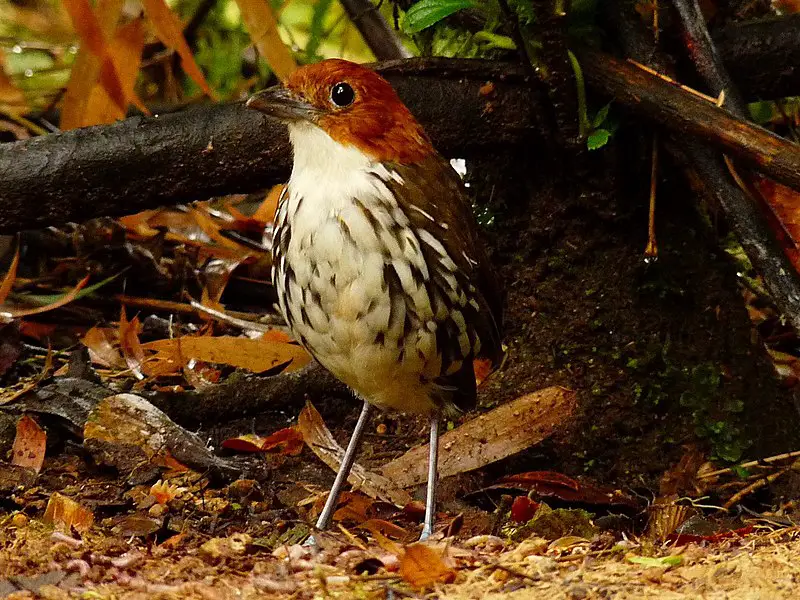
Antpittas are small passerine birds found in Central and South America. They measure 10-20 cm (4-8 inches) in length, making them some of the smallest members of their family Grallariidae.
These birds have a close relationship with both antbirds and gnateaters, which they were formerly placed alongside within the Formicariidae group.
Antpittas typically inhabit subtropical to tropical climates located near streams or other body water sources like rivers, ponds etc., where they forage for food on land but also take occasional dips into nearby bodies of water if needed.
In North America there is one species known as Ochthoeca frontalis which mainly inhabits Mexico’s western mountain ridge regions from Jalisco to Sonora states.Scientific classification:
| Kingdom | Animalia |
| Phylum | Chordata |
| Class | Aves |
| Order | Passeriformes |
| Infraorder | Tyrannides |
| Parvorder | Furnariida |
| Family | Grallariidae P.L. Sclater and Salvin[1], 1873 |
35. Blue-Tufted Starthroat
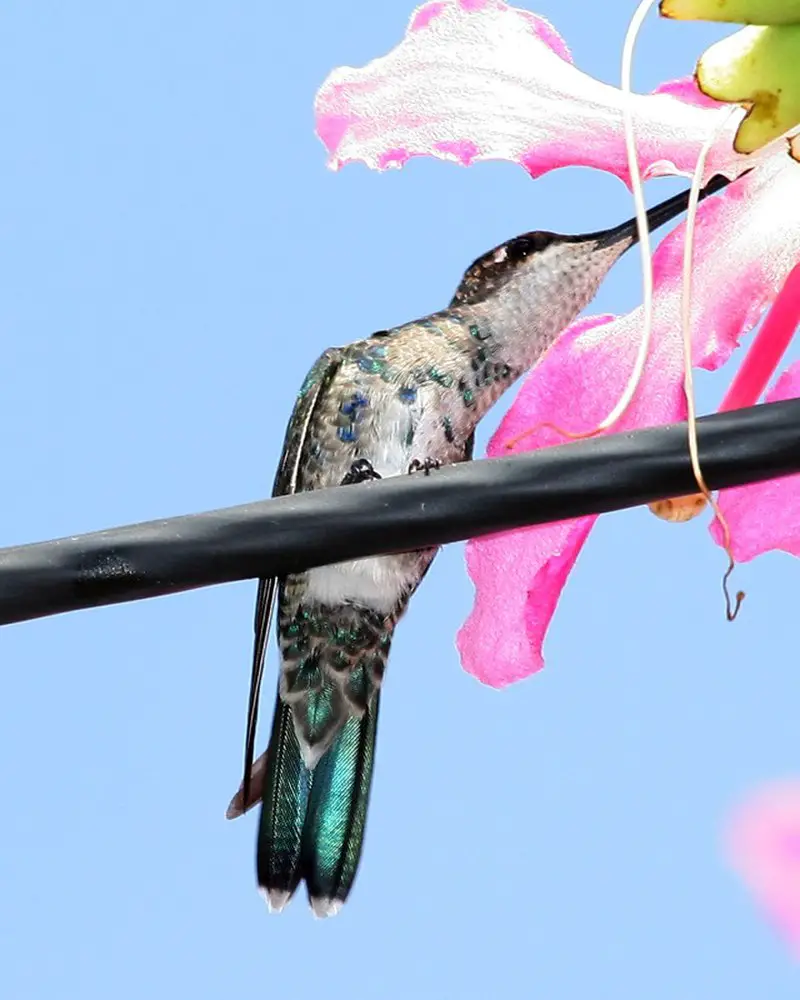
The Blue-tufted Starthroat is a beautiful species of hummingbird found throughout South America. Its distinct blue feathers stand out against its otherwise light colored body, making it easy to spot in the wild.
It belongs to the mountain gems tribe Lampornithini and subfamily Trochilinae, which also includes other popular hummingbirds like the Anna’s Hummingbird and Rufous Hummingbird. The Blue-tufted Starthroat prefers mountainous areas where they feed on nectar from various flowering plants as well as insects for protein.
While once believed to be its own genus, Heliomaster furcifer has since been reassigned with three similar species within this group: White-eared Hummingbird, Speckled Hummingbird and Stripe-tailed Hummingbird. All four of these birds make up an incredible array of vibrant colors that can brighten even dull days.Scientific classification:
| Kingdom | Animalia |
| Phylum | Chordata |
| Class | Aves |
| Order | Apodiformes |
| Family | Trochilidae |
| Genus | Heliomaster |
| Species | H. furcifer |
36. Picazuro Pigeon
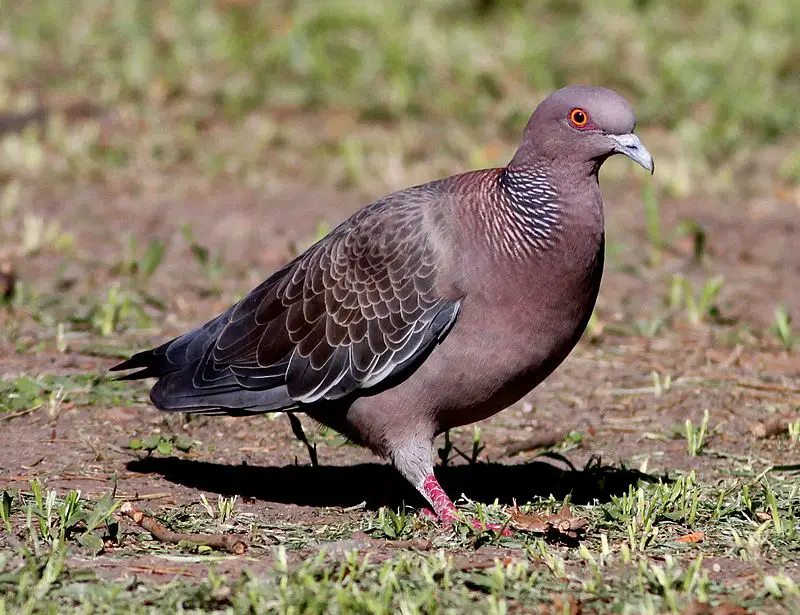
The Picazuro pigeon is a large, brown species native to South America. It has white dashes on the back of its neck and darker brown wing patterns which give it similarity with spotted doves.
This bird typically has a wingspan of up to 22 inches and can weigh as much as one pound. Its range includes Argentina, Bolivia, Brazil, Paraguay and Uruguay.
These pigeons are monogamous creatures that form long-term pair bonds for life; they build nests from twigs in trees or shrubs near water sources such as ponds or streams where they lay their eggs and raise their young together until fledging occurs after about four weeks post hatching.
They feed primarily on grains but will also eat some invertebrates when available seasonally.Scientific classification:
| Kingdom | Animalia |
| Phylum | Chordata |
| Class | Aves |
| Order | Columbiformes |
| Family | Columbidae |
| Genus | Patagioenas |
| Species | P. picazuro |
37. Brown-Hooded Gull
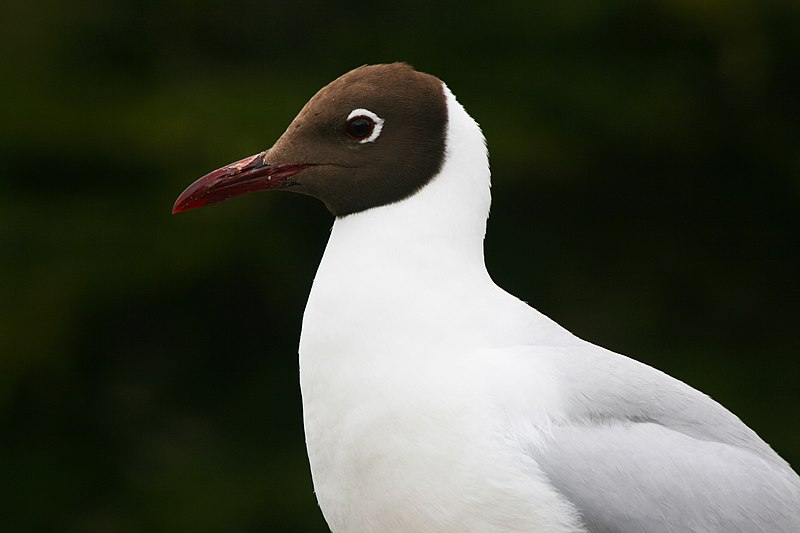
The brown-hooded gull is a species of white seabird found in South America. It has red beak and feet, and its most distinctive feature is the dark brown head with a white semicircle around the back part of each eye.
The bird’s scientific name, Chroicocephalus maculipennis translates to ‘spotted wings’ which refers to its spotted wing feathers.
This gull can typically be seen along coasts or near bodies of water where it feeds on fish, insects, crustaceans and mollusks.
They are also known for their long distance migrations from Argentina all the way up to Uruguay during winter months when food becomes harder to find closer by shorelines.
To protect themselves they build nests high above ground usually made out of twigs lined with grass and other materials nearby them like seaweed or shells that they scavenge while searching for prey underwater throughout day light hoursScientific classification:
| Kingdom | Animalia |
| Phylum | Chordata |
| Class | Aves |
| Order | Charadriiformes |
| Family | Laridae |
| Genus | Chroicocephalus |
| Species | C. maculipennis |
Also Featured In: Common Birds that Live around Ushuaia,
38. Brazilian Teal
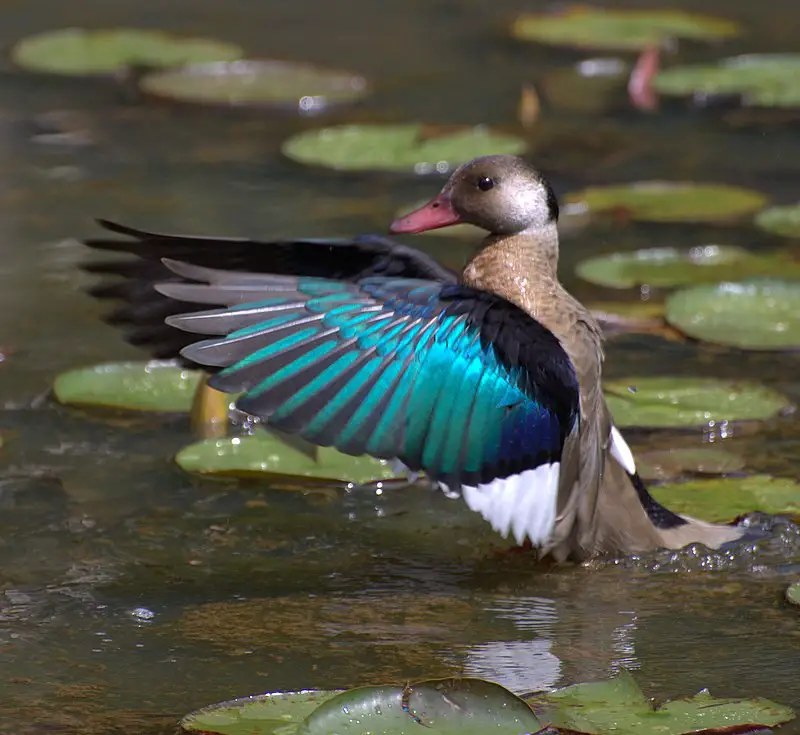
The Brazilian teal is the only duck in its genus, Amazonetta brasiliensis. This species of waterfowl can be found all over eastern South America and was formally described by German naturalist Johann Friedrich Gmelin back in 1789.
It stands out for its unique features including a green head with white lines on either side that extend down to the neck, as well as bright yellow spots near the eyes and bill. The body has varying shades of brown feathers which darken towards their tail end.
Their wings are capable of strong flight allowing them to traverse large distances while searching for food such as insects, frogs and small fish they find at shallow waters or marshes during breeding season when they mate around October-November period every year before migrating again shortly after laying eggs in April-May period.Scientific classification:
| Kingdom | Animalia |
| Phylum | Chordata |
| Class | Aves |
| Order | Anseriformes |
| Family | Anatidae |
| Subfamily | Anatinae |
| Genus | Amazonetta von Boetticher, 1929 |
| Species | A. brasiliensis |
39. White-Faced Whistling Duck
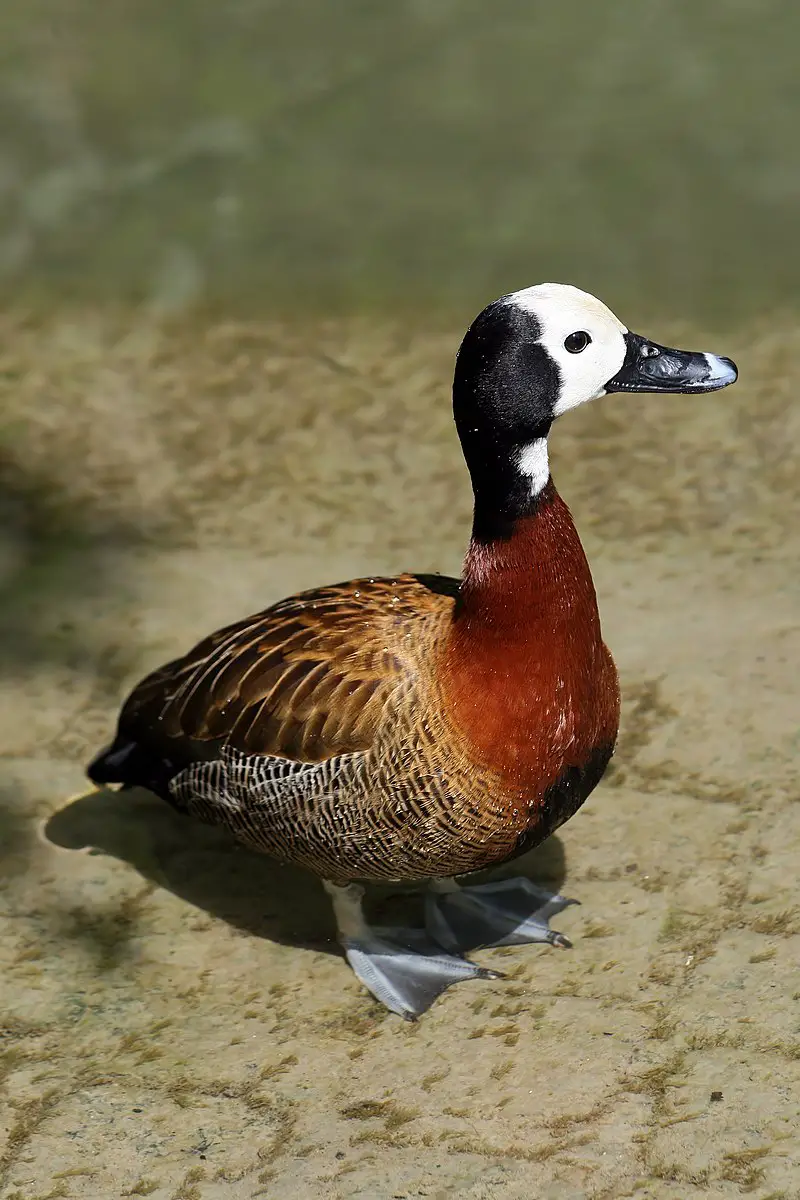
The white-faced whistling duck is a highly social bird native to sub-Saharan Africa and South America. It can be easily identified by its distinct three-note whistling call, as well as its long grey bill.
In the right conditions, it’s not uncommon to spot large flocks of these ducks numbering in the thousands at dawn – an incredible sight.
This species usually lives near bodies of water such as swamps or rivers where they feed on plant matter like grasses and grains which they graze on during the day.
When night falls, they fly off into trees nearby in search of safety from predators before returning to their feeding grounds when morning arrives again.Scientific classification:
| Kingdom | Animalia |
| Phylum | Chordata |
| Class | Aves |
| Order | Anseriformes |
| Family | Anatidae |
| Genus | Dendrocygna |
| Species | D. viduata |
40. Picui Ground Dove
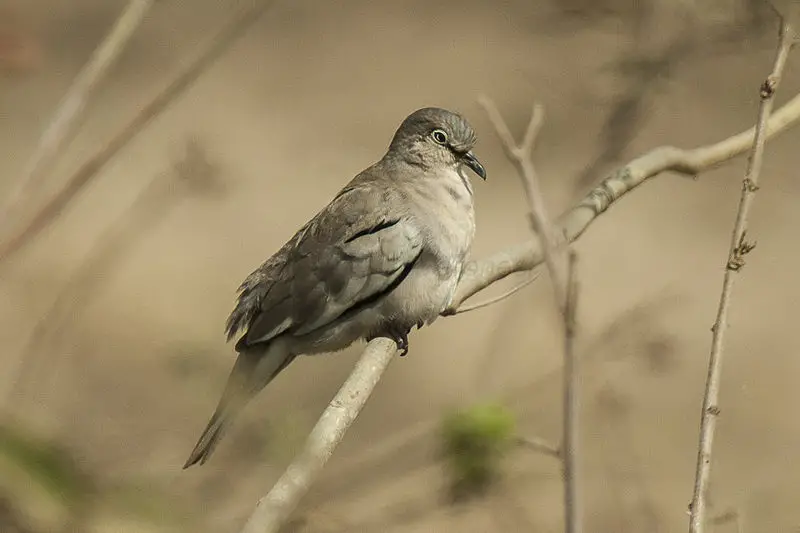
The Picui Ground Dove is a species of bird found primarily in South America. It has two subspecies, the nominate C. p. picui and C. p. strepitans, which can be found in Argentina, Bolivia, Brazil, Chile, Colombia Paraguay Peru and Uruguay.
This small dove prefers to inhabit open woodland areas with dense undergrowth or scrub vegetation near water sources such as ponds or streams where it feeds on seeds and other plant matter available nearby while croaking calls are uttered by both sexes during breeding season that typically commences at the start of rainy season from December-March depending upon its location within range territory.
The Picui Ground Dove is often considered a sister species to the Croaking Ground Dove (Columbina cruziana) due to their similar characteristics including plumage colouration but also behavioural traits such as foraging habits throughout their respective ranges across South America.Scientific classification:
| Kingdom | Animalia |
| Phylum | Chordata |
| Class | Aves |
| Order | Columbiformes |
| Family | Columbidae |
| Genus | Columbina |
| Species | C. picui |
41. Giant Wood Rail
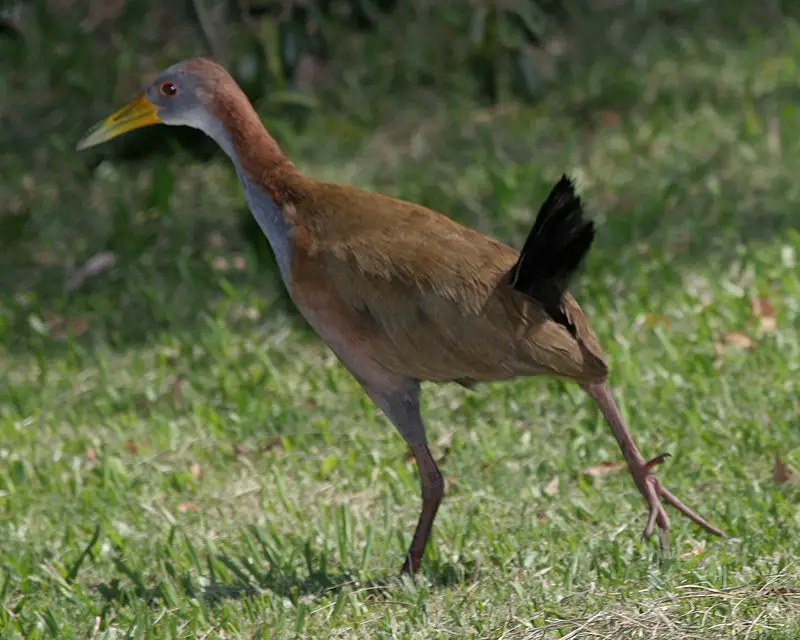
The Giant Wood Rail is a species of bird that belongs to the Rallinae subfamily in the rail, crake and coot family. It inhabits Argentina, Bolivia, Brazil, Paraguay and Uruguay.
Its length ranges from 41-45 cm (16-18 inches). Females can weigh up to 765 g (27 oz) while males are usually much lighter – around 640 g (23 oz).
They have a striking blackish plumage on their head with white stripes running down onto their back.
Their wings also show white edges which contrast against its dark feathers beautifully. The bill is long and yellowish or olive green making it quite distinctive among other birds of its kind.
This amazing creature helps maintain balance in nature through seed dispersal as they feed mostly on grains during rainy season when food resources become abundant for them.Scientific classification:
| Kingdom | Animalia |
| Phylum | Chordata |
| Class | Aves |
| Order | Gruiformes |
| Family | Rallidae |
| Genus | Aramides |
| Species | A. ypecaha |
42. Wattled Jacana
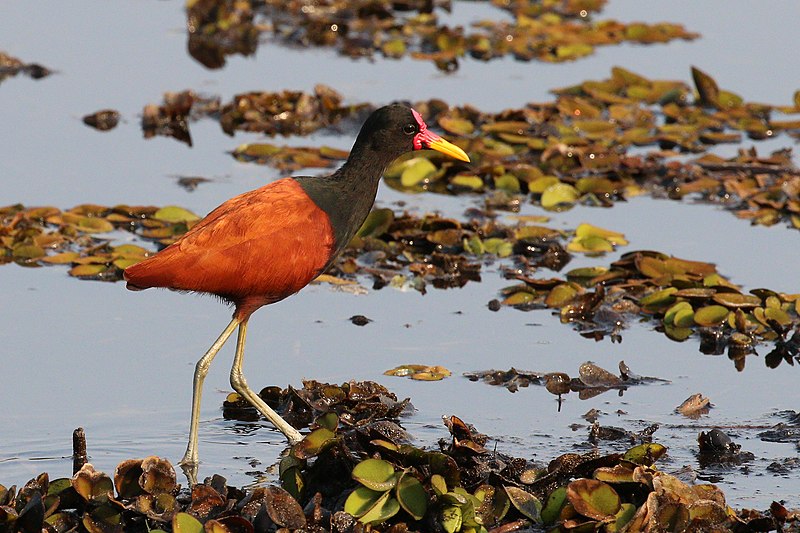
The Wattled Jacana is a stunning bird from central and south America. It has long legs, a black head with yellow wattles at each side, and striking chestnut brown wings.
This wader builds its nest on the surface of ponds or lakes using floating vegetation such as lily pads to anchor it in place – usually with four eggs that are darkly marked.
The male takes primary responsibility for incubation of these eggs between his wings, while the female will take care of her chicks once they hatch out.
These birds feed mainly on aquatic insects but also small fish and amphibians if available.
Overall this species is an interesting and attractive addition to any wetland habitat.Scientific classification:
| Kingdom | Animalia |
| Phylum | Chordata |
| Class | Aves |
| Order | Charadriiformes |
| Family | Jacanidae |
| Genus | Jacana |
| Species | J. jacana |
43. Chiloé Wigeon
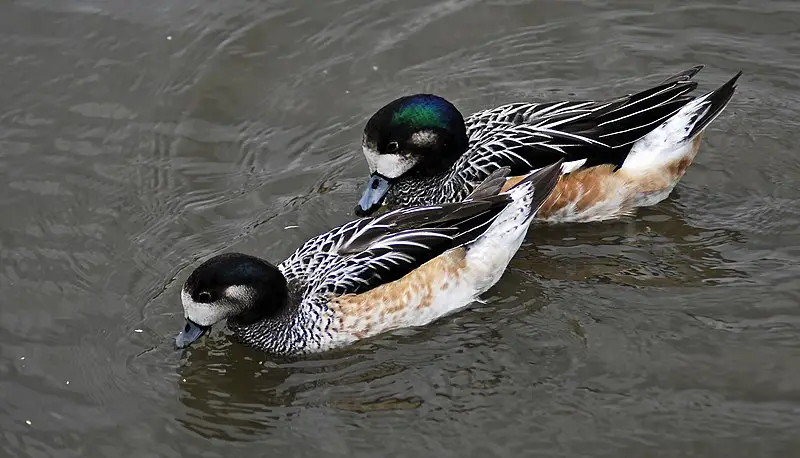
The Chiloé Wigeon is a species of dabbling duck native to the southern parts of South America, including the eponymous Chiloé Archipelago. It has an unmistakable plumage – brown and white with light gray patches on its head and neck.
The wigeon can be found in freshwater lakes, marshes, swamps and lagoons throughout its range. They mostly feed on aquatic vegetation but have also been observed eating insects.
This species is sometimes known as Pato Overo (“piebald duck”) or Pato Real (“royal duck”) due to their striking colouration which stands out among other waterfowls in the region.
Although not globally threatened at present, local populations may be declining owing to hunting pressure and habitat destruction caused by human activities such as agriculture expansion and wetland drainage projectsScientific classification:
| Kingdom | Animalia |
| Phylum | Chordata |
| Class | Aves |
| Order | Anseriformes |
| Family | Anatidae |
| Genus | Mareca |
| Species | M. sibilatrix |
Also Featured In: Birds That Live around East Falkland,
44. Darwin’s Rhea
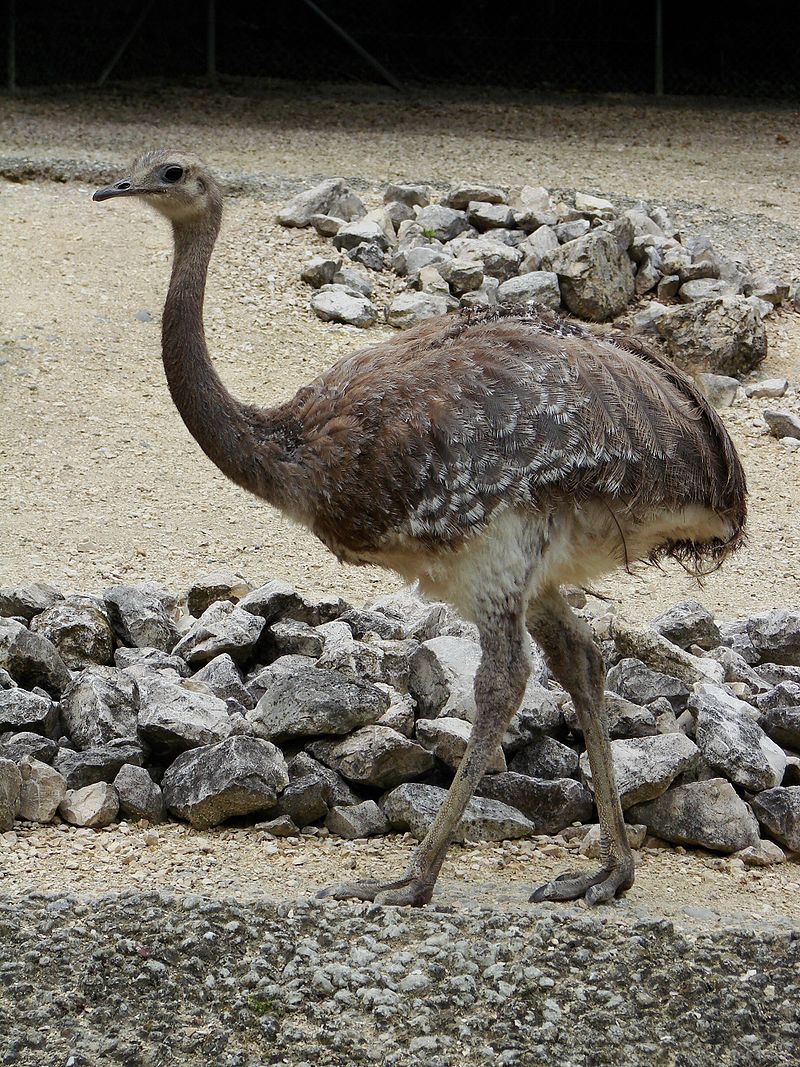
Darwin’s rhea is a flightless bird, the smaller of two extant species of rheas. It stands at 35 to 39 inches tall and has an average length of 36-39 inches with a weight range between 33 – 63 lbs.
The head and bill are both quite small in size compared to other ratites.
This large bird can be found across Altiplano and Patagonia regions in South America where it feeds on plants such as grasses, herbs, roots, bark, fruits etc., while also occasionally consuming insects and lizards.
Most notably they use their powerful legs for running away from predators like foxes or pumas who may attempt to hunt them down due to its slow speed when taking off or flying away isn’t possible.Scientific classification:
| Kingdom | Animalia |
| Phylum | Chordata |
| Class | Aves |
| Infraclass | Palaeognathae |
| Order | Rheiformes |
| Family | Rheidae |
| Genus | Rhea |
| Species | R. pennata |
45. Magellanic Penguin
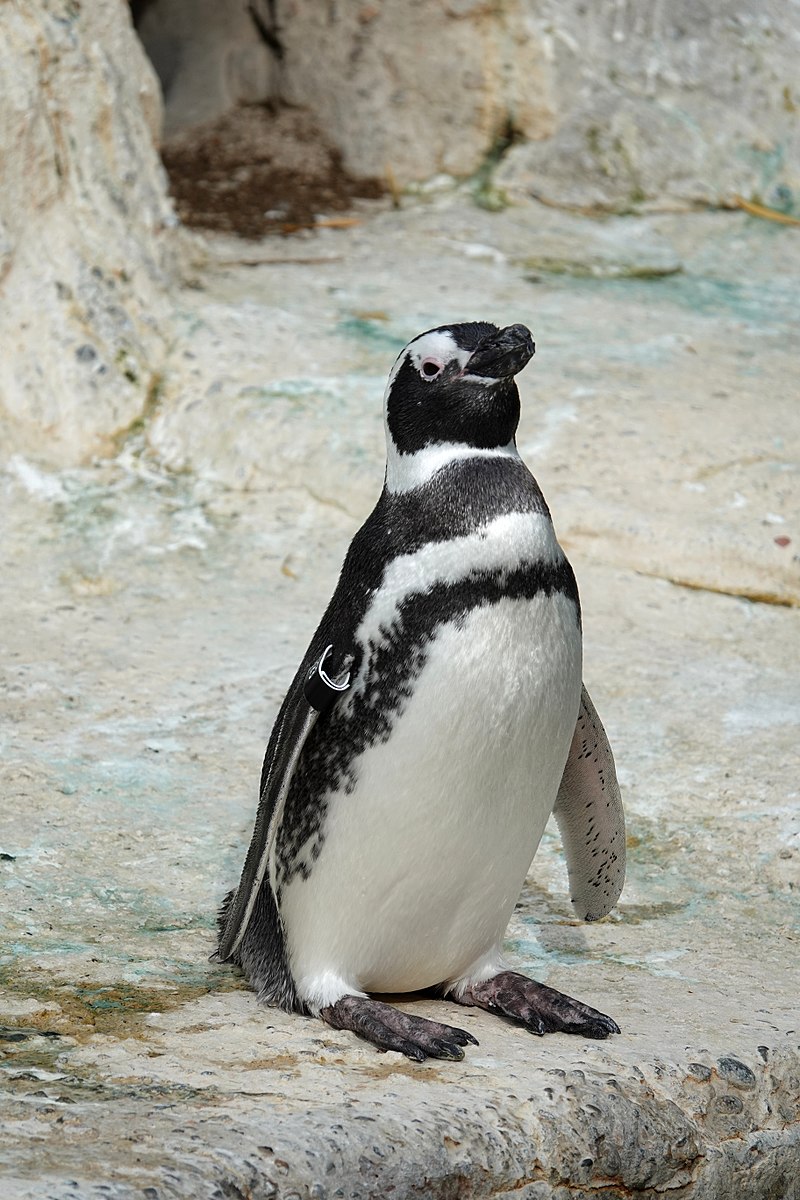
The Magellanic penguin is a beloved South American bird that breeds in coastal Patagonia, including Argentina, Chile and the Falkland Islands. It migrates to Brazil and Uruguay occasionally as far north as Espirito Santo.
Vagrants have even been spotted in El Salvador, Antarctica’s Avian Island and Australia/New Zealand.
This species of penguin is perhaps most recognizable for its striking black-and-white plumage – it has an entirely white underbelly with two distinctive stripes across its back which are black above and white below.
Additionally, they possess large pinkish feet which act like paddles when swimming underwater; these birds can swim up to 20 mph.
The Magellanic Penguin typically lives around 15 years but some may live longer due to their strong social bonds within colonies.
All in all this majestic creature makes quite the statement both on land or sea – making them a unique addition our planet’s wildlife population.Scientific classification:
| Kingdom | Animalia |
| Phylum | Chordata |
| Class | Aves |
| Order | Sphenisciformes |
| Family | Spheniscidae |
| Genus | Spheniscus |
| Species | S. magellanicus |
Also Featured In: Native Birds Of West Falkland, Jason Islands Birds You Didn’t Know
46. Saffron Finch
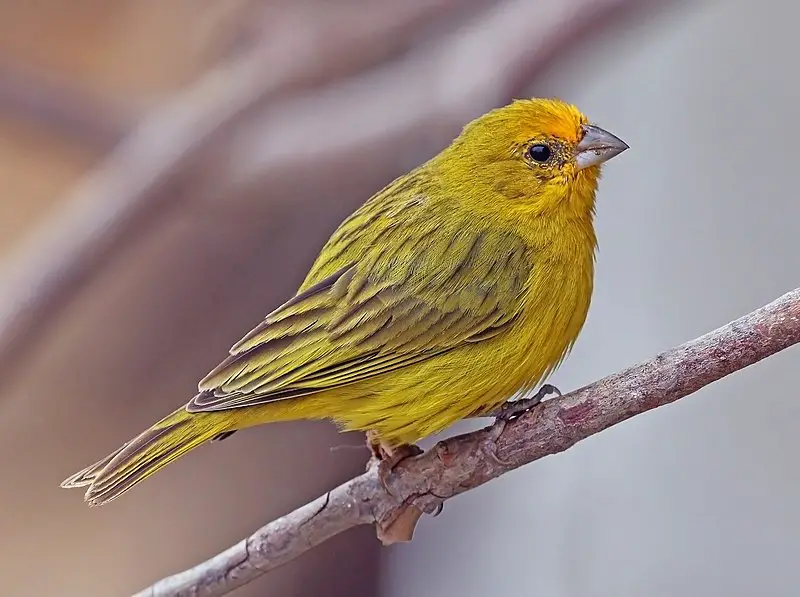
The Saffron Finch is a small tanager bird found in South America. This delightful species has an extensive distribution, ranging from Colombia to eastern Brazil and Bolivia.
They inhabit open or semi-open habitats at low elevations outside the Amazon Basin.
With their easily recognizable bright yellow feathers and cheerful song, they are often seen perching on roofs in northern Venezuela where they are referred to as “canario de tejado”.
In southern Brazil these birds are known as “canário-da-terra”, which translates into native canary.
Their diet consists mainly of seeds, grains and insects such as grasshoppers, caterpillars and beetles.
Although not threatened with extinction yet, deforestation may soon reduce their available habitat significantly if measures aren’t taken to conserve it now.Scientific classification:
| Kingdom | Animalia |
| Phylum | Chordata |
| Class | Aves |
| Order | Passeriformes |
| Family | Thraupidae |
| Genus | Sicalis |
| Species | S. flaveola |
Also Featured In: Most Common Oahu Birds, Hawaii Big Island Birds You Should Know
47. Rheas
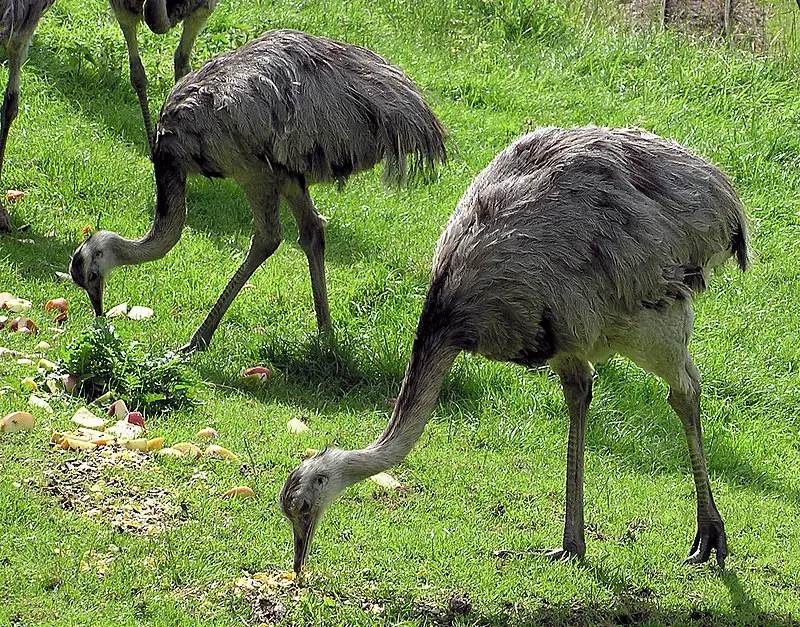
Rheas are large flightless birds native to South America, related to the ostrich and emu. There are two extant species: The Greater or American Rhea (Rhea americana) and the lesser or Darwin’s Rhea (Pterocnemia pennata).
They have long legs, strong feet with three toes that help them run swiftly on land; they can also swim well.
Their wings may be small but they’re used for balance during running. These birds usually weigh between 30-60 pounds depending on the species, with a length of up to 6 ft.
Both male and female rheas display plumage in shades of greyish browns which blend into their surroundings – perfect camouflage.Scientific classification:
| Kingdom | Animalia |
| Phylum | Chordata |
| Class | Aves |
| Infraclass | Palaeognathae |
| Order | Rheiformes |
| Family | Rheidae |
| Genus | Rhea Brisson, 1760 |
48. Magellanic Woodpecker
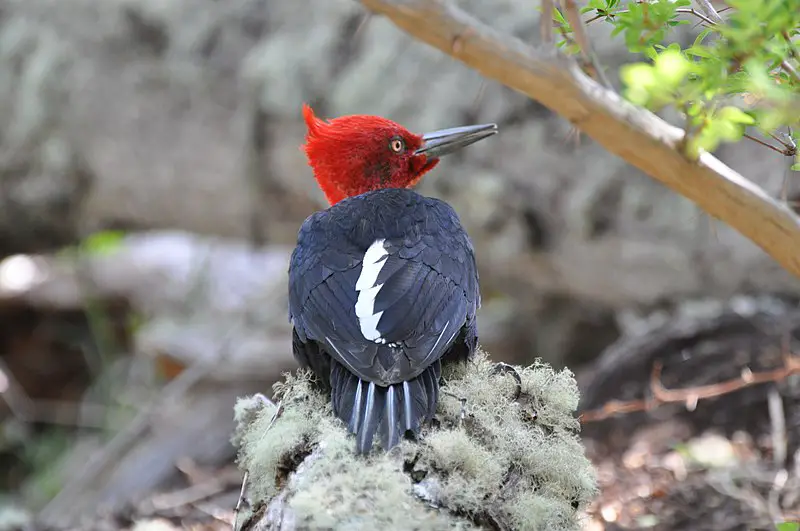
The Magellanic woodpecker is a large species of bird found in the southern regions of Chile and Argentina. It is part of the Campephilus genus, which includes iconic birds such as ivory-billed woodpeckers.
This species can grow to be up to 45 cm (18 inches) long, with males weighing an average of 320 grams (11 ounces). Its plumage consists mostly of black feathers on its head, wings and backside; it has white markings covering its belly area.
The most distinct feature about this bird is its red crest that runs from behind their bill down over their neck and shoulders – hence giving them their name ‘Magellanic’.
These beautiful creatures are known for making loud drumming noises as they search for food like beetles, ants or other insects in tree trunks or branches.
They inhabit dense forests areas where they can find plenty to eat while avoiding being preyed upon by predators.Scientific classification:
| Kingdom | Animalia |
| Phylum | Chordata |
| Class | Aves |
| Order | Piciformes |
| Family | Picidae |
| Genus | Campephilus |
| Species | C. magellanicus |
49. Chalk-Browed Mockingbird
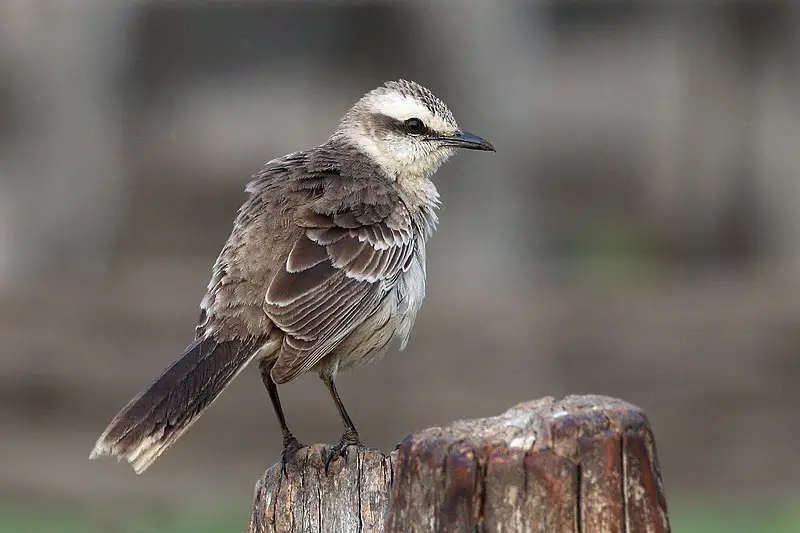
The Chalk-browed mockingbird is a species of bird belonging to the family Mimusidae, found in South America. It has four subspecies and measures between 23.5 and 26 cm long, weighing 55 to 73 g on average.
Its plumage is greyish brown with darker wings, white stripes above the eyes and chestnut underparts that merge into its back feathers creating an ombre effect. They are usually seen alone or in pairs singing their loud melodies throughout open areas such as grasslands or fields with scattered trees.
Their diet consists mainly of insects but also includes fruits from time to time depending on availability which makes them omnivores by nature.
They feed during morning hours followed by active periods of foraging after sunset when temperatures are cooler making it easier for them to find food sources quickly before night falls again along with roosting spots in dense vegetation nearby where they rest until dawn arrives once more.Scientific classification:
| Kingdom | Animalia |
| Phylum | Chordata |
| Class | Aves |
| Order | Passeriformes |
| Family | Mimidae |
| Genus | Mimus |
| Species | M. saturninus |